Magical beings appear across cultures in various forms, representing human hopes, fears, and beliefs. These beings take on a multitude of appearances and roles, often embodying traits that reflect the cultural values and challenges of the societies that imagine them. Here’s an exploration of different magical beings across cultures:
Fairies
Fairies, or “fae,” have been central to many cultures and have different forms depending on the region. While modern depictions often show fairies as small, delicate winged creatures, they were originally much more diverse and complex.
- Characteristics: Fairies can be small or large, beautiful or monstrous, helpful or harmful. They are often seen as mischievous, unpredictable beings with a tendency to cause harm if disrespected, though they can also assist humans in need.
- Historical Interpretations:
- In medieval and early modern Europe, fairies were sometimes equated with demons or other supernatural dangers, especially in the context of witch trials.
- Victorian depictions, such as those of artists like Cicely Mary Barker, often portrayed fairies as small, delicate, and nature-associated, moving away from the darker, more threatening fairy imagery of earlier periods.
- Role in Folklore: Fairies often reside in natural spaces, such as forests, hills, and lakes, and are sometimes thought to control natural forces. They may steal children, cause illness, or interfere with human affairs, but they are also thought to offer blessings and assistance if treated well.
Elves
Elves are present in numerous mythologies, including Norse, Germanic, and Celtic traditions.
- Norse Elves: In Norse mythology, elves were spiritual beings closely connected to nature, sometimes seen as helpful spirits and sometimes as a more elusive, mysterious force.
- Celtic Elves: Elves in Celtic traditions are often akin to fairies, inhabiting the “Otherworld,” a realm separate from human existence. They could be benevolent or malicious, depending on the context.
- Contemporary Portrayal: Modern depictions of elves are heavily influenced by fantasy literature, especially J.R.R. Tolkien’s Lord of the Rings, where elves are often wise, graceful, and immortal beings.
Gnomes
Gnomes are small, earth-dwelling beings in European folklore.
- Characteristics: Gnomes are often depicted as wise but reclusive, living underground or within the earth, where they protect treasures or guard hidden knowledge. They are sometimes thought to be protectors of nature, especially of the forests and mines.
- Modern Interpretations: In modern culture, gnomes have been relegated to whimsical garden decorations, but in older traditions, they were seen as elemental creatures closely tied to the earth and nature spirits.
Trolls
Trolls are most commonly associated with Scandinavian folklore.
- Characteristics: Trolls are often depicted as large, ugly, and hostile creatures, sometimes living in caves or under bridges. They are frequently considered dangerous, tricksters, and sometimes even man-eating.
- Role in Folklore: Trolls are commonly portrayed as foes of humans, often depicted in tales where heroes must outwit or defeat them. They are sometimes believed to be related to giants or supernatural beings of the wild.
Angels and Spirits
Angels are divine beings in various religious traditions, such as Christianity, Judaism, and Islam.
- Angels: Typically messengers of God, angels appear in many cultures, often with wings and a divine purpose. In the Abrahamic faiths, angels serve as intermediaries between humans and the divine, carrying out tasks or delivering messages.
- Spirits: Spirits exist in nearly all cultures as supernatural entities tied to ancestors, nature, or the elements. They can be protective, vengeful, or helpful, and are often tied to rituals and beliefs about life after death. In some traditions, spirits may be revered as guides or honored as protectors.
Jinn
In Arab and Islamic folklore, jinn are supernatural beings made from smokeless fire.
- Characteristics: Jinn can be good, evil, or neutral. They are capable of shapeshifting and influencing human behavior, and they often inhabit places like deserts, ruins, and remote areas.
- Role in Folklore: Jinn are central to many Middle Eastern stories, often interacting with humans through possession, wishes, or curses. Some stories of jinn, like the One Thousand and One Nights, present them as powerful beings who grant wishes or offer assistance, while others highlight their trickster nature.
Mermaids
Mermaids are half-human, half-fish beings featured in folklore across Europe, Asia, and Africa.
- Characteristics: Mermaids are often depicted as beautiful, with long flowing hair, and the ability to sing enchanting songs. While traditionally associated with perilous beauty, they can also symbolize longing, mystery, and the unknown.
- Role in Folklore: In many traditions, mermaids are seen as dangerous creatures that lure sailors to their deaths. However, other cultures view them more as protectors of the sea or as symbols of fertility.
Banshees
The banshee is a figure in Irish and Scottish folklore, known as a harbinger of death.
- Characteristics: Typically depicted as a wailing woman, the banshee’s cry is believed to foretell the death of a family member. In some traditions, she is seen as a protective spirit who mourns the loss of loved ones.
- Role in Folklore: Banshees are often linked with the spirit world and ancestral protection, warning families of impending death.
Native American “Little People”
Various Native American cultures feature stories of little people, mystical creatures with magical abilities.
- Characteristics: These beings are often small in size, with the power to shape-shift or to influence human behavior. Some are seen as tricksters, while others help those who show respect for the natural world.
- Role in Folklore: “Little people” are connected with nature and the balance of the earth, often appearing in tales that emphasize harmony with nature or the consequences of disrespecting the land.
Cultural and Regional Variations
- Irish Traditions: Fairies in Irish folklore are often believed to be fallen angels or the descendants of ancient gods, with a strong connection to the land and natural forces.
- Scandinavian Traditions: Trolls, sea-trows, and dwarfs are deeply embedded in Scandinavian mythology, often linked to giants or elemental spirits of the earth and sea.
- Asian and Arab Traditions: In Malay, Burmese, and Arab folklore, similar fairy-like beings are also revered, each with unique traits and roles but echoing the magical powers seen in European and Middle Eastern traditions.
Theories on Origins
- Ancestral Spirits: Some believe that many magical beings, such as fairies and spirits, are derived from ancestral spirits, ghosts, or deities that are thought to influence the world of the living.
- Memory of Past Peoples: Another theory suggests that many supernatural beings originated as stories about ancient or aboriginal peoples, their characteristics evolving over time to take on magical attributes.
- Environmental Influence: The introduction of iron or new technologies, such as weapons, may have contributed to stories about magical beings, marking a divide between the supernatural and human worlds.
Conclusion
Magical beings have evolved to embody the cultural values, fears, and hopes of societies throughout history. From helpful elves and benevolent spirits to malevolent trolls and mischievous fairies, these beings offer insight into the human imagination, reflecting how we relate to the world around us and the mysteries that lie beyond our understanding. Their characteristics and roles continue to evolve in modern interpretations, ensuring their place in both traditional and contemporary folklore.
The Welsch Beings
Welsh folklore is rich with magical beings, many of which share similarities with other Celtic traditions but also have unique characteristics shaped by the Welsh landscape, history, and culture. Here are some key magical beings from Welsh folklore:
Fairies (Tylwyth Teg)
The Tylwyth Teg are the Welsh equivalent of fairies, often portrayed as beautiful, ethereal, and mischievous beings, similar to their counterparts in Irish and Scottish mythology. The name “Tylwyth Teg” translates roughly to “Fair Family” or “Fair Folk.”
- Characteristics: The Tylwyth Teg are often depicted as small, graceful, and otherworldly, sometimes with the ability to shapeshift. They are considered to be fair and beautiful but also known for their capricious nature.
- Role in Welsh Folklore: These fairies live in secluded, hidden places such as deep forests, hills, or lakes. It is said that they can be helpful but will take offense if disrespected, leading to misfortune for humans who cross them. Some stories suggest that the Tylwyth Teg could abduct humans or animals, just as fairies are sometimes believed to do in other Celtic traditions.
- Relations with Humans: The Tylwyth Teg are known to sometimes help humans, offering guidance or treasures, but the risk of offending them is always present. For example, if a human enters their domain without permission or does something to anger them, the fairy folk could cause illness or misfortune.
The Cŵn Annwn (Hounds of Annwn)
In Welsh mythology, the Cŵn Annwn are spectral hounds that serve the ruler of the Otherworld, Annwn (the Welsh realm of the dead). These hounds are often depicted as white or pale, with glowing red eyes.
- Characteristics: The Cŵn Annwn are powerful, otherworldly creatures with supernatural abilities, often associated with death and the afterlife. They are sometimes seen as harbingers of doom, or as creatures that hunt souls.
- Role in Welsh Folklore: These hounds are thought to be part of a hunt led by Arawn, the ruler of Annwn, and are said to appear during the Wild Hunt, a mythical chase through the skies or the wilderness. The hounds’ eerie howls were believed to signal death or misfortune for those who heard them.
- Cultural Influence: The Cŵn Annwn are often linked to the idea of the Wild Hunt, which appears in many European traditions. They are sometimes compared to other mythological hounds, such as the Irish Cú Síocháin or the English Hounds of Hell.
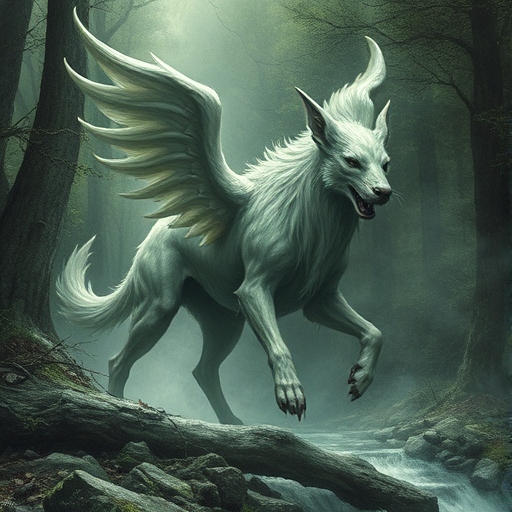
Bwbach (or Bwbachod)
The Bwbach (plural: Bwbachod) is a household spirit in Welsh folklore, similar to other domestic spirits like the Brownies in Scottish tradition.
- Characteristics: The Bwbach is a small, mischievous creature, often described as invisible or shapeshifting. While they are generally harmless, they can play tricks on humans, such as hiding household objects or making a mess.
- Role in Welsh Folklore: The Bwbach is typically a protector of the home, watching over the household in exchange for small offerings, such as food. However, if the family fails to treat the Bwbach kindly or neglects their duties, the creature might cause trouble, leading to accidents or misfortunes.
- Cultural Context: The Bwbach is part of the broader category of household spirits, which appear in various cultures and serve to explain everyday occurrences that might otherwise seem mysterious or out of place.
The Afanc
The Afanc is a terrifying creature in Welsh folklore, often described as a giant water monster or a dragon-like being. It is said to inhabit lakes and rivers.
- Characteristics: The Afanc is a large, dangerous creature, sometimes depicted as a crocodile, a giant beaver, or a water serpent. It is known for its fearsome appearance and violent behavior.
- Role in Welsh Folklore: The Afanc is considered a monster that terrorizes the local people, often causing floods or other disasters. The Afanc is sometimes said to be a guardian of water or treasure, making it a formidable foe for any who seek to exploit its domain.
- Legends: In one popular Welsh legend, the Afanc is said to have been defeated by the hero CuChulainn (a figure who crosses Welsh and Irish mythology). In some versions, the creature is driven out of a lake, which is then associated with the presence of this powerful being.
The Cailleach (The Old Woman)
While the Cailleach is primarily associated with Scottish and Irish mythology, she also appears in Welsh folklore, though her role is less prominent.
- Characteristics: The Cailleach is often depicted as an old, crone-like figure, a goddess of winter and storms. She is believed to control the weather, bringing both harsh winters and the renewal of spring.
- Role in Welsh Folklore: The Cailleach is said to create weather patterns and is sometimes associated with the land’s cycles of life and death. Her presence is connected to the natural forces that shape the Welsh countryside, and she may appear as a force of nature, both destructive and restorative.
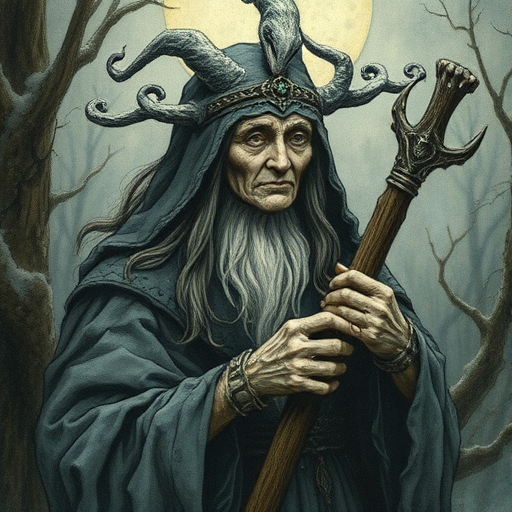
Pwca (Puck)
The Pwca is a mischievous spirit in Welsh folklore, similar to the Puck from English folklore and the Púca from Irish traditions.
- Characteristics: The Pwca is a shape-shifter, often taking the form of an animal such as a goat or horse, though sometimes it appears as a human or a supernatural being. It is known for its mischievous nature, tricking and playing pranks on humans, especially travelers.
- Role in Welsh Folklore: The Pwca can be both playful and dangerous. In some stories, the Pwca is considered a protector of the land, while in others, it leads people astray, causing confusion or harm. Its trickster qualities make it both feared and respected by those who encounter it.
- Cultural Influence: The Pwca is often associated with wild places like forests and mountains, areas that are seen as liminal spaces between the known and the unknown.
The Mabinogion
Many of these magical beings appear in the Mabinogion, a collection of Welsh myths and legends. The stories within the Mabinogion include gods, kings, and magical creatures, blending elements of Celtic folklore with the history and landscape of Wales.
- Key Themes: These tales often feature magical beings and encounters with otherworldly creatures, such as the Fair Folk, magic-using deities, and otherworldly creatures that challenge heroes on quests or lead them through magical realms.
- Examples: Some of the most famous characters in the Mabinogion include Rhiannon, a goddess-like figure with magical abilities, and Arianrhod, who is associated with the moon and the stars. Many of the stories involve transformations, enchantments, and journeys to the Otherworld.
Conclusion
Welsh folklore is full of rich, magical creatures that reflect the culture’s deep connection to nature, the land, and the mystical realms. From the beautiful and capricious Tylwyth Teg to the eerie Cŵn Annwn, these beings are intricately tied to Welsh identity and landscape, offering tales of mystery, adventure, and caution. The folklore also showcases a distinct blend of Celtic, pre-Christian, and Christian influences, making Welsh magical beings complex and multifaceted in their roles and symbolism.
The German Beings
German folklore is rich with magical beings, many of which stem from ancient mythological traditions, Christian influences, and regional beliefs. These beings, from mischievous spirits to powerful deities, embody a wide range of traits and roles in the stories of the German-speaking world. Here’s a deep dive into some of the most notable magical beings in German folklore:
**The Weißes Frauen (White Women)
White Women are spectral, often ghostly figures in German folklore, known for their haunting presence in remote forests, mountains, or castles.
- Characteristics: White Women are usually portrayed as sorrowful or tragic figures, often dressed in white gowns. They may be seen walking alone in desolate places, sometimes near bodies of water or in ruins. Their appearance is associated with forewarning or death, and they are considered omens.
- Role in Folklore: In many tales, White Women are believed to be the spirits of women who died in tragic circumstances, such as unrequited love, betrayal, or murder. They are often seen as warning travelers, but their appearances are thought to signal impending doom or misfortune for those who encounter them.
Der Schwarze Mann (The Boogeyman or The Black Man)
Der Schwarze Mann is the German equivalent of the boogeyman, a frightening figure often invoked by parents to warn children to behave.
- Characteristics: The Black Man is often depicted as a dark, shadowy figure or a monstrous being who preys on misbehaving children. He may appear as a tall, menacing figure or as an ambiguous, indistinct shape. Some versions describe him as a creature who kidnaps children, takes them away, or causes them harm.
- Role in Folklore: The Black Man serves as a fearsome figure to scare children into obedience, though he is also a symbol of the unknown and of fears about the dangers that lurk in the dark.
Die Nixe (The Nix or Water Nymph)
The Nixe (or Nixie) is a water spirit found in Germanic folklore, similar to the water sprites of Celtic mythology.
- Characteristics: The Nixe is often depicted as a beautiful, seductive creature, sometimes with the upper body of a woman and the lower body of a fish, similar to the concept of mermaids. They are believed to live in rivers, lakes, or other bodies of water.
- Role in Folklore: Nixes are known for their enchanting songs and ability to seduce humans, particularly men, drawing them into the water where they may drown. While they may appear gentle or helpful, they are often seen as dangerous, luring unsuspecting people to their doom. In some tales, however, the Nixe is also seen as a protector of the water and its creatures.
Die Loreley
The Loreley is a famous figure from German folklore, often associated with the Rhine River.
- Characteristics: Loreley is usually depicted as a beautiful woman sitting on a rock by the river, combing her golden hair. Her enchanting beauty and songs are said to attract sailors and cause them to crash their ships against the rocks.
- Role in Folklore: The Loreley is a symbol of the dangers of the Rhine and serves as an emblem of both beauty and destruction. Her legend is famous in German literature, particularly in poems and songs, where she lures sailors to their deaths with her captivating presence.
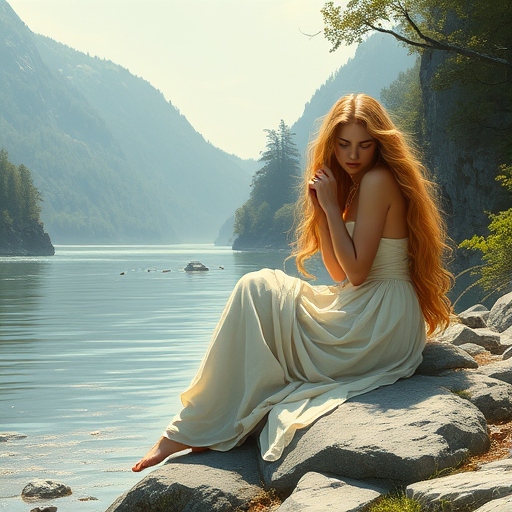
Die Heinzelmännchen (The Kobolds)
The Heinzelmännchen are small, mischievous creatures from German folklore, similar to the household spirits found in other European traditions, like the Brownies in Scotland or the Bwbach in Wales.
- Characteristics: Heinzelmännchen are described as tiny, helpful creatures that live in houses and assist with household chores when the humans are not around. They are typically invisible but are known for performing tasks such as cleaning, sewing, and cooking.
- Role in Folklore: The Heinzelmännchen are benevolent and enjoy helping, but they can become offended if humans take them for granted. In one famous story from Cologne, the Heinzelmännchen stop helping when a woman tries to catch them, showing that these creatures value respect and humility. Once their help is no longer appreciated, they disappear, leaving the household in chaos.
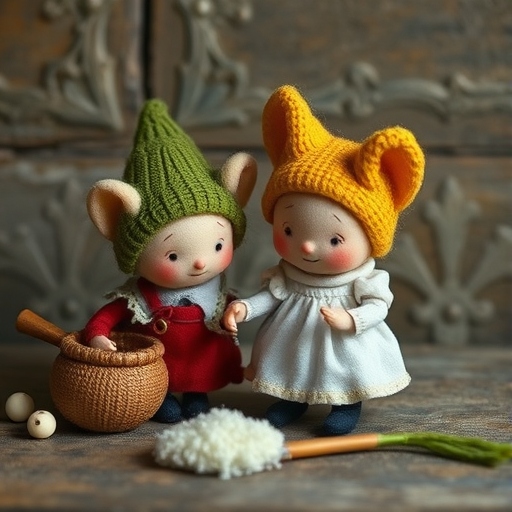
Der Riese (The Giant)
Giants feature prominently in Germanic and Norse mythology, and many stories of giants exist within German folklore.
- Characteristics: Giants are often depicted as enormous, powerful beings with extraordinary strength, sometimes possessing magical abilities. They are often portrayed as fierce, destructive forces of nature, but some giants can also be wise and helpful.
- Role in Folklore: German giants are often antagonistic forces that oppose gods, heroes, or humans. In some stories, giants are thought to live in the mountains or remote places, and they are sometimes seen as the builders of great structures. The Jotunn (or Jötnar) in Norse mythology, for example, are giants who frequently conflict with gods like Thor. In German stories, giants are sometimes protectors of the natural world, standing as symbols of the untamed forces of nature.
Die Waldgeister (Forest Spirits)
Waldgeister are spirits associated with the forests in German folklore.
- Characteristics: These spirits are often invisible but are believed to inhabit the trees, rocks, and streams of the forest. They are sometimes described as tiny, elf-like creatures or as glowing lights that lead travelers astray, similar to the will-o’-the-wisps found in other European traditions.
- Role in Folklore: Waldgeister are believed to protect the forest and its inhabitants, but they are also known to mislead travelers who venture too far from the path. They may cause confusion, accidents, or disorientation. In some stories, they may help those who show respect for the natural world, guiding them to safety or revealing hidden knowledge.
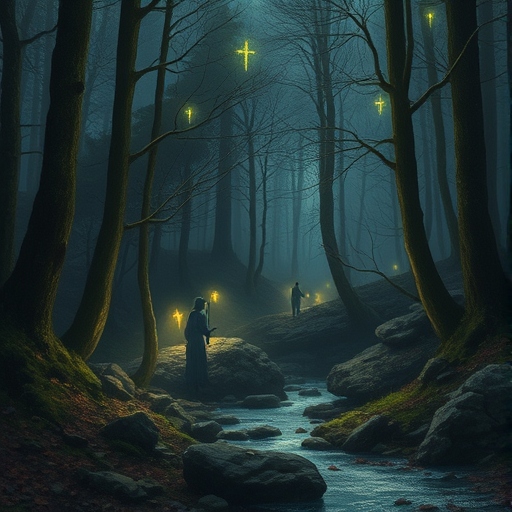
Der Krampus
Krampus is a well-known figure in Alpine and Germanic folklore, especially associated with Christmas traditions.
- Characteristics: Krampus is a half-goat, half-demon creature who accompanies Saint Nicholas during the Christmas season. While Saint Nicholas rewards well-behaved children, Krampus punishes those who have been naughty.
- Role in Folklore: Krampus is a figure of fear, depicted as a horned, hairy, and terrifying being carrying chains and a bundle of birch sticks to punish misbehaving children. In some versions of the tradition, Krampus kidnaps children or drags them off to his lair. The figure of Krampus is often seen in holiday parades and festivals, where he appears as a dark counterpart to Saint Nicholas.
Die Elfen (Elves)
Elves in German folklore are similar to those in other European traditions but have distinct roles and characteristics.
- Characteristics: German elves are often described as small, ethereal beings, sometimes with magical powers and often connected to nature. They can be helpful or mischievous, depending on the story.
- Role in Folklore: Elves in German folklore can be seen as protectors of the natural world, especially forests and mountains. They are also thought to be capable of granting wishes or helping humans in times of need, but they may also cause harm or mischief if angered. In medieval German legends, elves are sometimes seen as spirits of the deceased or as beings from a magical realm.
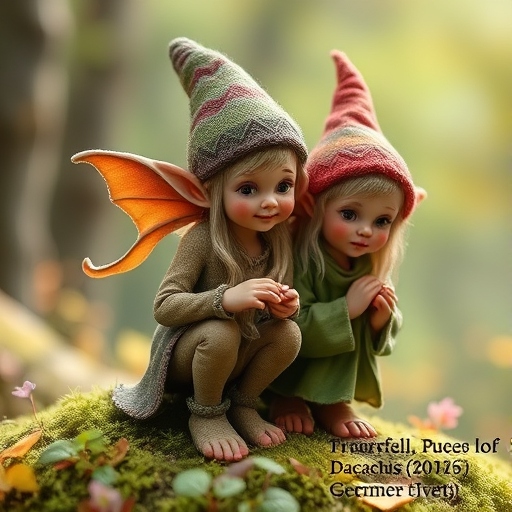
Die Teufel (The Devils)
The figure of the Devil in German folklore is often a trickster figure, embodying temptation, evil, and the darker aspects of human nature.
- Characteristics: The Devil in German folklore is often depicted as a malevolent figure, sometimes with horns, a tail, and other devilish attributes. He may appear as a tempter, offering power or wealth in exchange for a soul.
- Role in Folklore: In many German tales, the Devil is a force of chaos, attempting to lead people astray or challenge heroes. One famous example is the story of Faust, a scholar who makes a pact with the Devil in exchange for knowledge and power. In some cases, the Devil is seen as an adversary to the forces of good, such as saints or divine figures.
Belarusian Beings
Belarusian folklore, like the folklore of many Slavic cultures, is rich with a variety of magical beings that reflect the region’s history, traditions, and connections to nature. These beings often embody the natural world, human virtues and vices, as well as the fears and hopes of the people. Here’s an overview of some of the key magical beings in Belarusian folklore:
Rusalka
The Rusalka is one of the most well-known figures in Belarusian folklore and shares similarities with water spirits in other Slavic traditions. Rusalkas are often depicted as young women, but their characteristics and behaviors can vary greatly.
- Characteristics: Rusalkas are usually described as beautiful young women with long, flowing hair. They are often associated with water sources like lakes, rivers, or ponds. In some stories, Rusalkas are said to be spirits of drowned women or young girls who died tragic deaths, such as through drowning or untimely deaths.
- Role in Folklore: Rusalkas are considered both benevolent and malevolent, depending on the story. Some tales describe them as playful spirits who dance in the moonlight by water, while others portray them as vengeful creatures who lure men into the water to drown them. In many Belarusian legends, Rusalkas are believed to rise from the water on certain days, especially during the Rusalka Week (a Slavic festival). They are often seen as embodiments of the spirit world, connected to nature’s cycles, death, and rebirth.
- Symbolism: Rusalkas are associated with fertility, death, and the liminal spaces between life and the afterlife. They embody the power of water, which is both life-giving and potentially dangerous.
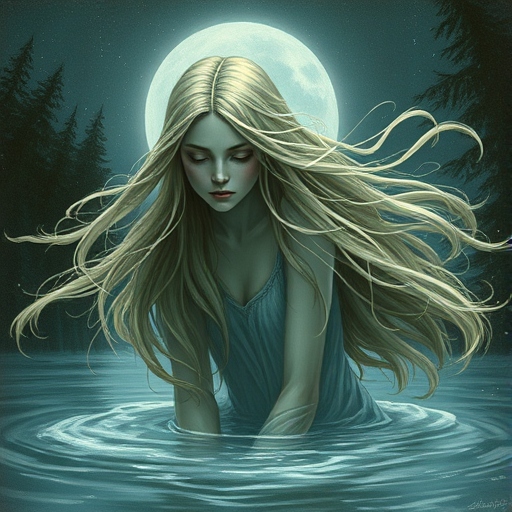
Domovoi
The Domovoi is a household spirit that appears in many Slavic cultures, including Belarusian folklore. Like many household spirits, the Domovoi is considered a protector of the home and its inhabitants.
- Characteristics: The Domovoi is usually described as a small, bearded man, sometimes appearing as an elderly figure. He is believed to live in the hearth or other central places of the home, where he oversees the well-being of the household. In some versions, the Domovoi may be seen as a protective figure, while in others, he is more neutral or even mischievous.
- Role in Folklore: The Domovoi’s role is to protect the home and the family. If treated with respect, he will ensure the household remains prosperous and free from misfortune. However, if he is disrespected or angered, he can cause trouble, such as making noise at night, hiding objects, or bringing illness to the family. In some cases, the Domovoi is also believed to have the power to foretell the future.
- Rituals and Offerings: To keep the Domovoi content, families would leave small offerings of bread, milk, or porridge at the hearth. In some cases, families would perform rituals or say prayers to invoke the Domovoi’s protection.
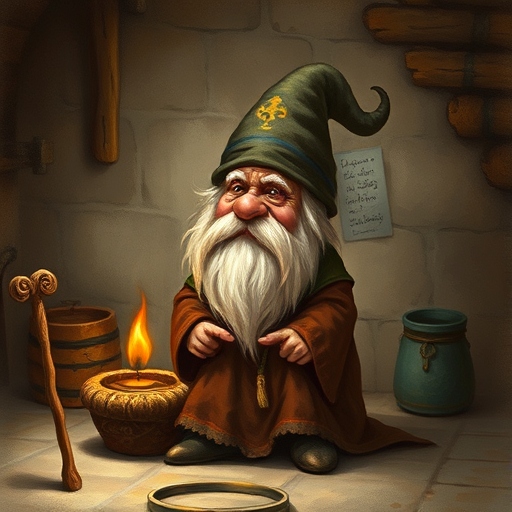
Leshy
The Leshy is a forest spirit, closely tied to the natural world, particularly the forests that dominate much of Belarus.
- Characteristics: The Leshy is often depicted as a tall man with a wild, unkempt appearance, sometimes resembling a giant or an old man of the woods. He is typically covered in bark, leaves, and forest debris, blending in with the trees and the wilderness. The Leshy is also said to be able to change his size, shrinking to the size of a tree stump or growing to the height of a giant.
- Role in Folklore: The Leshy is a guardian of the forest and its creatures. He is known for guiding or misleading travelers who enter the forest, sometimes causing them to become lost or leading them to danger. While the Leshy is not inherently malicious, he is mischievous and can play tricks on those who do not respect the forest. He can also be a protector of animals and is thought to maintain the balance of nature.
- Interactions with Humans: It is believed that if someone encounters a Leshy, they should show respect for the forest. Those who treat the Leshy and his domain with care are likely to receive his protection, while those who disrespect the forest may suffer from confusion, lost belongings, or worse. The Leshy is also believed to be capable of transforming into animals, such as wolves or bears.
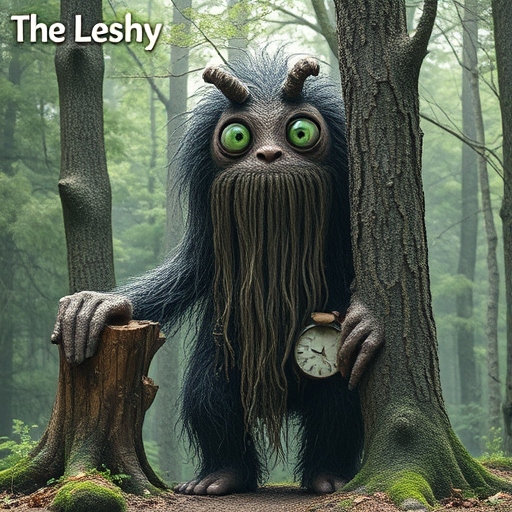
Baba Yaga
The infamous Baba Yaga is a prominent figure in Belarusian folklore, as well as in other Slavic traditions. She is one of the most iconic witches in European folklore.
- Characteristics: Baba Yaga is usually depicted as an old, ugly, and fearsome witch, often living in a hut that stands on chicken legs. She is known for her sharp, iron teeth and her ability to fly in a mortar, wielding a pestle. Despite her frightening appearance, she is not always evil and sometimes plays the role of a helper or guide in folklore.
- Role in Folklore: Baba Yaga is often portrayed as a supernatural figure with the ability to control the elements, cast spells, and predict the future. She can be both a wise mentor and a malevolent force, depending on the tale. In many stories, she is a guardian of the forest or a figure who tests the bravery and morality of those who encounter her. She can assist or hinder those who visit her hut, depending on how they approach her.
- Symbolism: Baba Yaga embodies the forces of nature and the cycle of life and death. She is often associated with wisdom, fertility, and the passage from one stage of life to another, but she also represents the darker aspects of life, such as death, transformation, and rebirth.

Kupala Night Spirits
In Belarusian culture, Kupala Night (celebrated during the summer solstice) is a time when spirits and magical beings are thought to roam freely. Many folklore creatures are connected to this celebration, and special rites are performed to protect oneself from evil spirits.
- Characteristics: During Kupala Night, spirits such as water nymphs, fairies, and other magical beings are said to be particularly active. They are often believed to have powers related to love, fertility, and the elements.
- Role in Folklore: Kupala Night is a time of magical transformations and celebrations of the natural world. It is believed that on this night, the boundary between the human world and the spirit world becomes thinner, and people are more vulnerable to the influence of magical beings. Rituals such as jumping over bonfires, searching for the “fern flower,” and dancing are meant to protect against evil spirits and invite good fortune.
Dziady
Dziady is a festival of ancestor worship in Belarus, during which spirits of the dead are believed to return and interact with the living.
- Characteristics: The spirits of deceased ancestors, known as Dziady, are honored during the festival. They are believed to return to their family homes during specific times of the year, especially around harvest time.
- Role in Folklore: During Dziady, families would set up offerings of food, drink, and candles to honor their ancestors. The spirits were thought to bring blessings or misfortune depending on how well they were treated during the festival. Dziady is an example of a deeper connection between the living and the dead in Belarusian folklore, where ancestors continue to play an important role in guiding and protecting their descendants.
Morozko (Father Frost)
Morozko, also known as Father Frost, is a winter deity in Belarusian folklore, similar to figures like Ded Moroz in Russian traditions.
- Characteristics: Morozko is depicted as an old man with a long beard, dressed in furs, and associated with the cold winter winds and frost. He is often seen as both a harsh and benevolent figure, depending on how humans interact with him.
- Role in Folklore: Morozko controls the cold and is believed to bring the harsh winter weather, but he can also offer warmth and protection to those who show respect. In some versions of the legend, he is portrayed as a figure who helps those in need, while in others, he can be vengeful and harsh, punishing those who fail to honor him or the winter season.
- Symbolism: Morozko is a symbol of winter, death, and rebirth, reflecting the cyclical nature of life and the changing seasons.
Japanese Beings
Japanese folklore is deeply rich with magical beings, spirits, and mythical creatures that span a wide range of forms, roles, and purposes. These beings, often referred to as yōkai (supernatural creatures) or yūrei (ghosts), have become integral to Japan’s cultural and spiritual identity. They are frequently associated with natural phenomena, human emotions, and the supernatural, and have been the subjects of stories, literature, and art for centuries.
Here’s an overview of some key magical beings in Japanese folklore:
Yōkai (妖怪)
Yōkai are supernatural creatures, spirits, or demons in Japanese folklore. They are often portrayed as strange, magical beings with a variety of powers and personalities. Some are malevolent and dangerous, while others are more benign or neutral.
Tengu (天狗)
- Characteristics: Tengu are bird-like creatures, typically depicted with human bodies and avian features such as wings or beaks. They are often shown with red faces and long noses. In some depictions, they resemble Buddhist monks, while others are more monstrous in appearance.
- Role in Folklore: Tengu are often seen as protectors of the mountains and forests, but they can be tricksters and sometimes aggressive toward humans. In many tales, they are skilled martial artists and are known for their supernatural abilities, such as the ability to fly or control the wind. Tengu are associated with mischief, but they also have a role in teaching humans discipline and respect.
- Symbolism: Tengu are often associated with the Shugendō tradition of mountain asceticism, where they are seen as spiritual beings with both protective and threatening aspects.
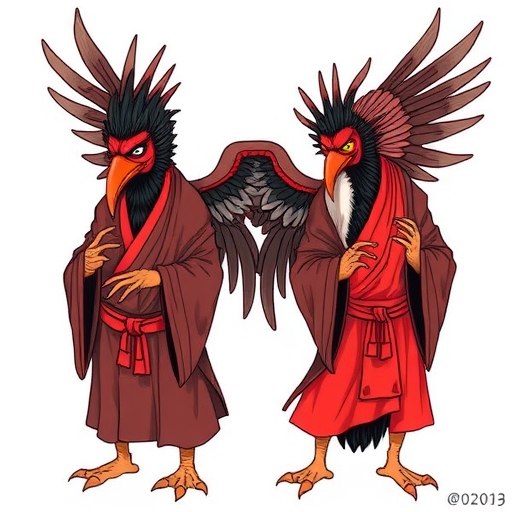
Kappa (河童)
- Characteristics: Kappa are amphibious creatures resembling turtles or frogs, with greenish skin and a humanoid appearance. They are often depicted with a dish-like depression on their heads, which holds water. If the water spills, the kappa loses its strength and power.
- Role in Folklore: Kappa are mischievous water spirits, often found in rivers and ponds. They are known for their tricks, such as challenging people to sumo wrestling matches or luring them into the water. They are said to be dangerous and have a habit of dragging children into the water to drown them. However, if a person bows to a kappa, the kappa will bow in return, causing the water in its head to spill, and it will lose its power.
- Symbolism: The kappa embodies the dangers of water and the fear of drowning, while also representing the importance of respect and humility.
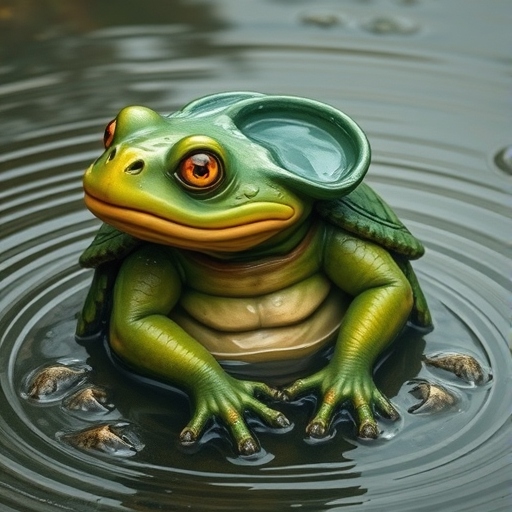
Oni (鬼)
- Characteristics: Oni are large, fearsome demons often depicted with horns, sharp claws, and wild hair. They are usually red or blue, with tusks and sometimes holding weapons like clubs. Oni have a terrifying, monstrous appearance.
- Role in Folklore: Oni are commonly portrayed as evil creatures that cause destruction, spread illness, and terrorize villages. They are often associated with hell or the afterlife in Japanese Buddhist cosmology. However, not all Oni are evil; some can be helpful or serve as protectors, depending on the story.
- Symbolism: Oni are symbolic of the darker, chaotic aspects of life, such as illness, misfortune, and evil. They also represent the struggle between good and evil and the fear of the unknown.
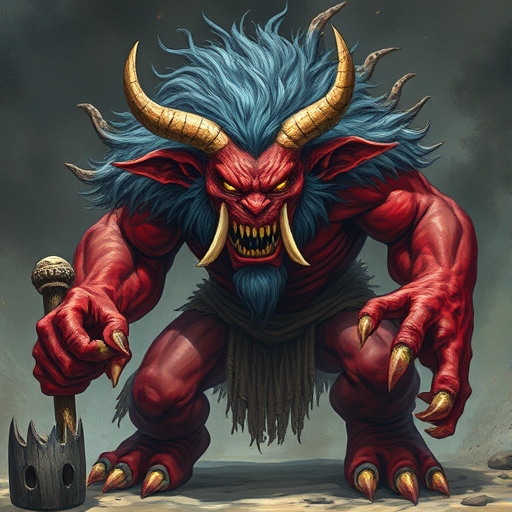
Yuki-onna (雪女)
- Characteristics: The Yuki-onna, or “Snow Woman,” is a ghostly figure associated with snowstorms. She is typically depicted as a beautiful, pale woman dressed in a white kimono with long black hair. Her presence is often accompanied by a cold, icy atmosphere.
- Role in Folklore: Yuki-onna is a vengeful spirit or yūrei who appears in snowstorms, freezing or killing travelers. Some stories depict her as a cold-hearted killer, while others show her as a tragic figure who expresses both sorrow and vengeance. In some variations of the tale, Yuki-onna falls in love with a man, and her story becomes a tragic love story where her icy nature creates an insurmountable barrier.
- Symbolism: The Yuki-onna represents both the beauty and danger of nature. She is a figure tied to the cold, and her haunting beauty reflects the deadly power of winter weather.
Kitsune (狐)
- Characteristics: Kitsune are foxes that possess magical abilities, often depicted as intelligent, beautiful, and with the ability to shape-shift into human form. In many stories, a kitsune appears as a woman, sometimes with multiple tails, with nine tails being the most powerful.
- Role in Folklore: Kitsune are often seen as messengers or servants of the deity Inari, the god of rice, fertility, and prosperity. While many kitsune are benevolent, helping people and bringing good fortune, others can be tricksters or malevolent beings that deceive or possess humans. Some stories suggest that kitsune can even marry humans, though the relationship can be complex and fraught with challenges.
- Symbolism: Kitsune are associated with intelligence, mystery, and duality—representing both benevolent and malicious forces. They are also linked to themes of love, transformation, and the supernatural power of the fox spirit.
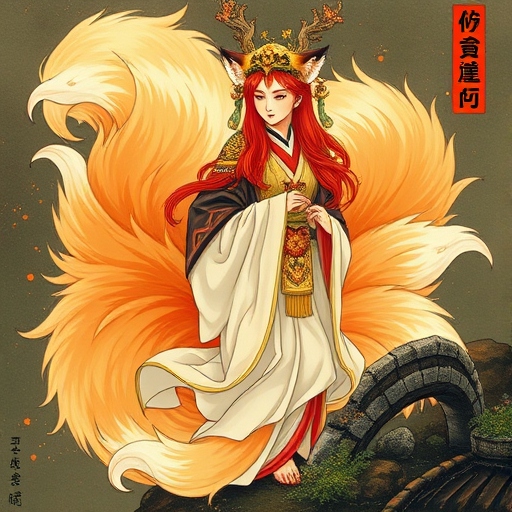
Yūrei (幽霊)
Yūrei are ghosts or spirits of the dead in Japanese folklore, often similar to Western concepts of ghosts, but with distinctive features rooted in Japanese spiritual beliefs.
Onryō (怨霊)
- Characteristics: Onryō are vengeful spirits of people who have been wronged in life. These spirits are driven by intense feelings of resentment or anger, and they seek to exact revenge on those who caused their suffering.
- Role in Folklore: Onryō are often depicted as female spirits who were wronged by lovers, family members, or society. They are seen as having the ability to cause harm to the living, often through supernatural means such as cursing or possessing people. The most famous onryō is Okiku, the ghost from the story of “Banchō Sarayashiki,” who seeks vengeance after being falsely accused of losing valuable plates.
- Symbolism: Onryō represent the unresolved emotions of the dead, especially when they die in injustice or tragedy. They embody the idea that deep emotional trauma can transcend death and manifest as destructive forces.
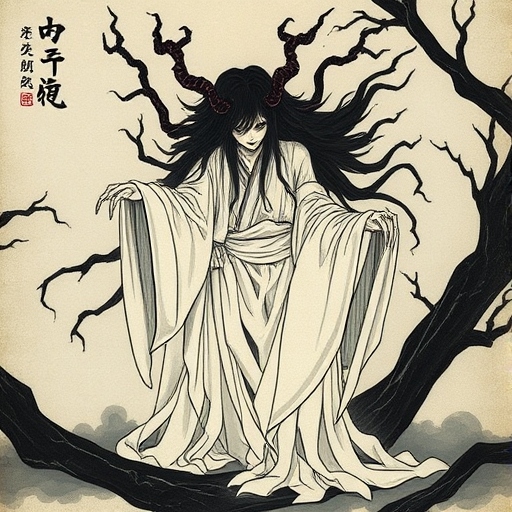
Yūrei (幽霊)
- Characteristics: Yūrei are restless spirits of the dead, typically depicted as pale, disheveled figures wearing white burial clothes and with long, unkempt hair. They often appear with empty, hollow eyes and are associated with haunted locations, such as abandoned buildings or graveyards.
- Role in Folklore: Yūrei are often spirits that have not found peace due to sudden or violent death, unfulfilled desires, or failure to perform proper burial rituals. They are believed to wander the earth in a state of unrest, sometimes appearing in places where they suffered or died. Yūrei are typically passive spirits that create an eerie, unsettling presence, though some may interact with the living in frightening ways.
- Symbolism: Yūrei represent the concept of the restless soul, the idea that death is not always the end and that unresolved emotions or improper rituals can trap a spirit between worlds. They reflect themes of grief, longing, and the need for closure.
Jorōgumo (絡新婦)
- Characteristics: Jorōgumo, or “Binding Bride,” is a spider spirit that can transform into a beautiful woman. She is often depicted as a seductive woman who entices men to her home before revealing her true form as a large, monstrous spider.
- Role in Folklore: The Jorōgumo lures men into her lair, where she traps them in her webs and either devours or kills them. She is also known to ensnare her victims in more figurative ways, using her beauty to manipulate and deceive.
- Symbolism: The Jorōgumo represents the danger of unchecked desire and the deadly consequences of being seduced by appearances. She embodies the duality of nature—something beautiful on the outside but deadly on the inside.
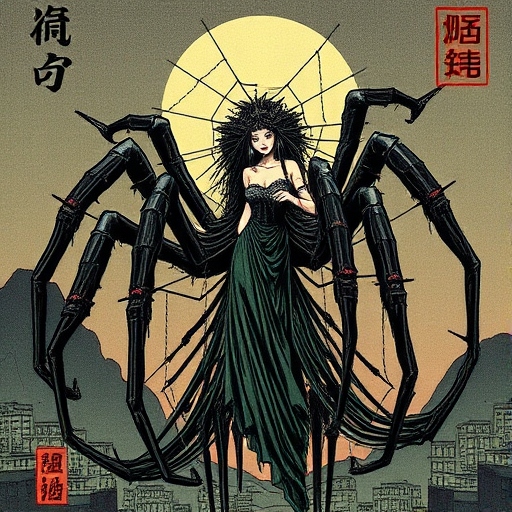
Yokai in Modern Popular Culture
In modern Japanese culture, many of these traditional yōkai and spirits have been adapted and reimagined in manga, anime, and video games. Popular figures such as Totoro from My Neighbor Totoro (though a more benign yōkai) and the spirits from Spirited Away have introduced younger generations to these ancient mythical beings, often in a more playful or whimsical light.
Conclusion
Japanese folklore features an extensive and diverse array of magical beings and spirits, each with unique traits and roles within their cultural narratives. These beings—whether they are mischievous yōkai like the Kappa, vengeful ghosts like the Onryō, or mystical creatures like the Kitsune—serve as reflections of the fears, moral lessons, and spiritual beliefs of the Japanese people. Whether benevolent or malevolent, these beings continue to captivate the imagination and influence both traditional and modern Japanese culture.
Chinese Beings
Chinese folklore, like that of many other cultures, is rich in magical beings, spirits, and legendary creatures that embody the complex relationship between humans and the supernatural. These beings are deeply intertwined with the natural world, the cosmos, and the human experience, often reflecting societal values, moral lessons, and natural phenomena. From gods and immortals to demons and spirits, these figures play crucial roles in Chinese myth and religion.
Here’s an overview of some of the key magical beings in Chinese folklore:
Dragons (龙, Lóng)
- Characteristics: Dragons in Chinese mythology are vastly different from the fearsome, fire-breathing dragons of Western folklore. They are generally benevolent, powerful, and auspicious creatures with serpentine bodies, antler-like horns, and claws. Chinese dragons are often depicted with a long, flowing body, resembling a snake, and are associated with water, weather, and the celestial realm.
- Role in Folklore: The dragon is a symbol of power, authority, and good fortune. It is believed to control the elements, especially water, rain, and rivers. In imperial China, the dragon was a symbol of the emperor, representing imperial authority and divine right. Dragons are also associated with wisdom and transformation. In many myths, the dragon appears as a force that brings prosperity, good harvests, and fertility, but it can also be wrathful when disrespected.
- Symbolism: The dragon represents strength, luck, and power, but also the balance between human and natural forces. It embodies the connection between heaven and earth, and its role as a protector and bringer of prosperity is central to many Chinese legends.
Immortals (八仙, Bāxiān)
- Characteristics: The Eight Immortals (Bāxiān) are legendary figures in Chinese folklore, often depicted as human beings who have attained immortality through spiritual cultivation or magic. Each immortal has distinct attributes, personalities, and powers. They are commonly portrayed as elderly figures, often with a carefree attitude and a sense of humor.
- Role in Folklore: The Eight Immortals are considered symbols of Taoist virtues and are often shown engaging in playful or heroic acts. They are also associated with good fortune, and their images appear in temples, art, and celebrations. They are believed to possess powers such as the ability to grant immortality, heal ailments, or change shape.
- Famous Immortals:
- Zhongli Quan: The leader of the immortals, often depicted with a fan that can turn stones into gold.
- Lü Dongbin: Known for his wisdom, he is often shown holding a sword that can banish evil spirits.
- He Xiangu: The only female immortal, often shown with a lotus flower, symbolizing purity and transformation.
Fox Spirits (狐狸精, Hú Lì Jīng)
- Characteristics: Fox spirits are a common theme in Chinese folklore. These are supernatural creatures capable of transforming into human forms, usually as beautiful women. They are often associated with seduction and trickery, but their roles can be both benevolent and malevolent, depending on the story.
- Role in Folklore: Fox spirits are believed to possess magical abilities, and their shape-shifting powers are often used to deceive or manipulate humans. In many tales, they seduce men, often draining their life force or causing them to fall into moral decay. However, not all fox spirits are malicious. In some stories, they are portrayed as protectors, healers, or helpers who bring good fortune. Some legends show fox spirits falling in love with humans and seeking redemption.
- Symbolism: Fox spirits represent the power of seduction, transformation, and the ambiguity between good and evil. They embody the idea of temptation and the consequences of human desires.
The White Snake (白蛇, Báishé)
- Characteristics: The White Snake is the central figure in one of China’s most famous folktales, “The Legend of the White Snake.” In the story, the White Snake is a powerful serpent spirit who transforms into a beautiful woman named Madame White Snake (Bái Shé Niáng). She falls in love with a human man, and their relationship is challenged by the forces of law and nature.
- Role in Folklore: The tale of the White Snake is a story of love, betrayal, and the struggle between the natural world and the human world. The White Snake’s magical powers and her transformation into human form reflect themes of immortality, forbidden love, and the clash between the supernatural and human society. The story has been adapted into many forms of Chinese opera, literature, and film.
- Symbolism: The White Snake symbolizes both the power of love and the tension between the human and supernatural realms. The tale highlights the conflict between fate, desire, and societal norms.
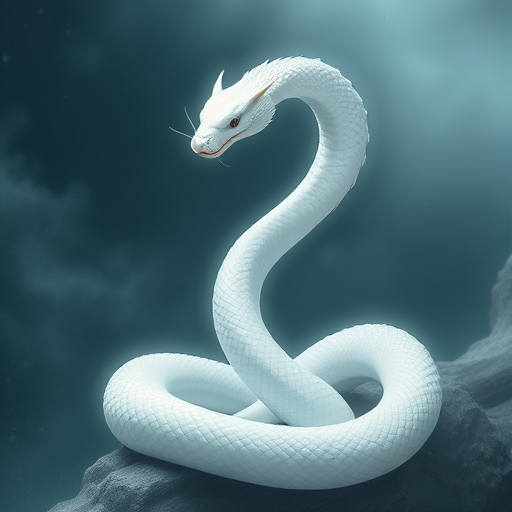
Jiangshi (僵尸)
- Characteristics: The Jiangshi, often referred to as a “hopping vampire,” is a reanimated corpse in Chinese folklore. It is typically depicted as a stiff, pale corpse that hops in search of life force to consume. The Jiangshi is usually an evil spirit, though in some stories, it can be controlled or contained by Taoist priests.
- Role in Folklore: The Jiangshi is associated with death, the afterlife, and the fear of the undead. The creature is often seen as a soul that has not properly passed into the afterlife, and it is typically considered a malevolent entity that preys on the living. In some versions, the Jiangshi can be repelled by certain rituals, such as hanging up mirrors, burning incense, or using special talismans.
- Symbolism: The Jiangshi represents the fear of death, the afterlife, and the consequences of improper burial rites. It also reflects the fear of the loss of one’s life force and the power of dark magic.
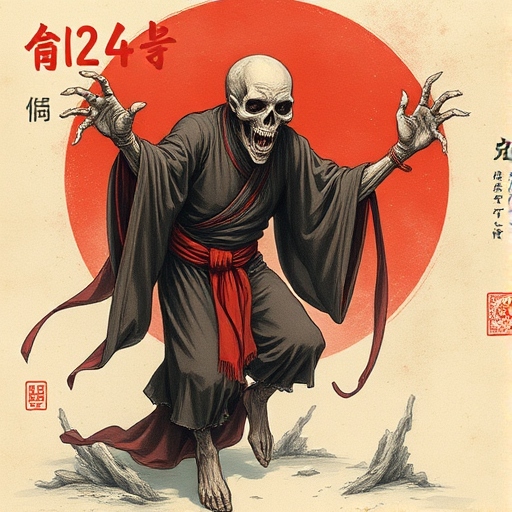
The Monkey King (孙悟空, Sūn Wùkōng)
- Characteristics: The Monkey King, or Sun Wukong, is the protagonist of one of China’s most famous classical novels, Journey to the West. He is a mischievous and powerful monkey who possesses great strength, intelligence, and magical abilities, such as shape-shifting, cloud walking, and wielding a magical staff that can change size.
- Role in Folklore: Sun Wukong is a trickster hero who rebels against the celestial order, challenging gods and spirits before eventually seeking redemption. He is a complex figure who represents both defiance and the quest for enlightenment. His adventures in Journey to the West take him on a pilgrimage with the monk Xuanzang to retrieve sacred Buddhist scriptures.
- Symbolism: The Monkey King symbolizes rebellion, transformation, and spiritual awakening. His character represents the conflict between ego and humility, and his eventual redemption illustrates the power of discipline, wisdom, and perseverance.
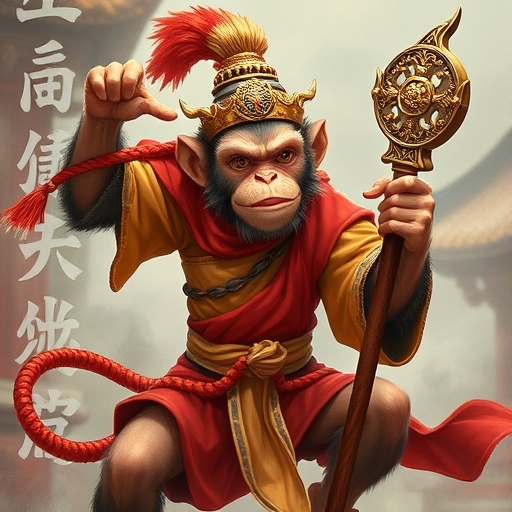
Bai Ze (白泽)
- Characteristics: Bai Ze is a mythical creature, often depicted as a lion-like beast with several eyes. According to legend, Bai Ze is a wise and knowledgeable being who shared secrets of the supernatural world with the Emperor of China.
- Role in Folklore: Bai Ze is known for its wisdom and ability to recognize yōkai and other supernatural beings. The creature is believed to have advised the emperor on how to defend the kingdom against evil spirits and demons. Bai Ze’s role is not only to protect but also to provide valuable knowledge about the unseen forces in the world.
- Symbolism: Bai Ze represents the pursuit of knowledge, protection, and the balance between the natural and supernatural realms. It is a guardian figure associated with wisdom and understanding of mystical forces.
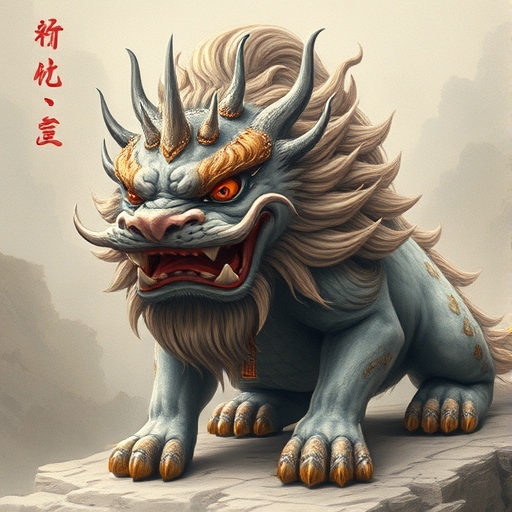
Guǐ (鬼) – Ghosts
- Characteristics: In Chinese folklore, Guǐ are ghosts or spirits of the dead, often restless souls that have not found peace. They are typically depicted as pale, wandering figures dressed in white or burial clothing.
- Role in Folklore: The presence of ghosts is tied to the belief in ancestor worship and the importance of proper funeral rites. Unresolved souls, particularly those who died violently or unjustly, are believed to become vengeful spirits. These spirits may haunt their living relatives or the places where they died. In some cases, the ghosts can be appeased through offerings, rituals, or prayers.
- Symbolism: Ghosts in Chinese folklore symbolize the unresolved emotions and lingering attachments of the dead. They represent the belief that the line between the living and the dead is fluid and that improper rites can cause spiritual unrest.
The Kitchen God (灶君, Zào Jūn)
- Characteristics: The Kitchen God is a household deity who oversees the family’s kitchen and hearth. He is typically depicted as a benevolent figure, sometimes portrayed as a fat, happy man.
- Role in Folklore: The Kitchen God is responsible for maintaining the family’s well-being and ensuring that food is abundant. At the end of each lunar year, the Kitchen God is believed to report the family’s behavior to the Jade Emperor, and families often offer him sacrifices to ensure a good report. The tradition of honoring the Kitchen God is an important part of the Chinese New Year celebrations.
- Symbolism: The Kitchen God represents domestic harmony, family prosperity, and the importance of proper conduct in everyday life. He is a guardian figure for the household, ensuring peace and prosperity.
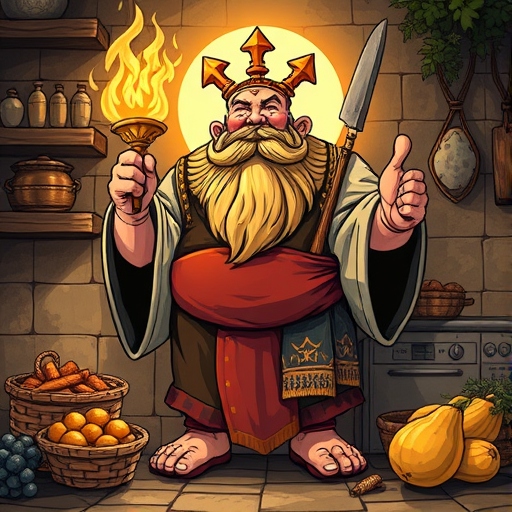
Conclusion
Chinese folklore is full of diverse and fascinating magical beings, each playing a distinct role in the cultural and spiritual landscape of the country. From the mighty dragons and immortal figures like the Eight Immortals to the shape-shifting fox spirits and mischievous ghosts, these creatures represent the complexities of life, death, and the supernatural. Their symbolism reflects the values of Chinese society, including the importance of balance, respect for ancestors, and the need for spiritual cultivation. These beings continue to inspire stories, art, and traditions that shape Chinese culture today.
Romanian Beings
Romanian folklore is rich with a variety of magical beings, supernatural creatures, and spirits, many of which have roots in pre-Christian beliefs and have evolved over time, blending local traditions with influences from other cultures in the Balkans, Slavic regions, and the broader European context. These entities often embody the intersection of natural and supernatural forces, representing both the wonder and danger that lurk beyond the human world. From benevolent spirits to malevolent forces, Romanian folklore is filled with mythical beings that reflect the country’s history, cultural practices, and religious beliefs.
Here are some of the most notable magical beings and creatures in Romanian folklore:
Strigoi
- Characteristics: The Strigoi are one of the most iconic supernatural beings in Romanian folklore, often depicted as restless spirits or the undead. These creatures are typically associated with the dead who rise from their graves, much like vampires. The term Strigoi can refer to both ghosts and vampires, but they are generally believed to be the souls of the dead who have unfinished business or were not properly buried.
- Role in Folklore: Strigoi are said to emerge from their graves during the night, causing harm to the living by draining their energy or life force. They are often associated with illness, misfortune, and death. In some legends, a person can become a Strigoi if they have led a sinful life or if they were born under certain omens. Family members may perform rituals to prevent a loved one from becoming a Strigoi, such as driving a stake through the body, decapitating the corpse, or placing garlic around the grave.
- Symbolism: The Strigoi represents the fear of death, the consequences of improper burial, and the lingering attachment of the deceased to the living. They also embody the intersection of life and death, emphasizing the fragile boundary between the two realms.
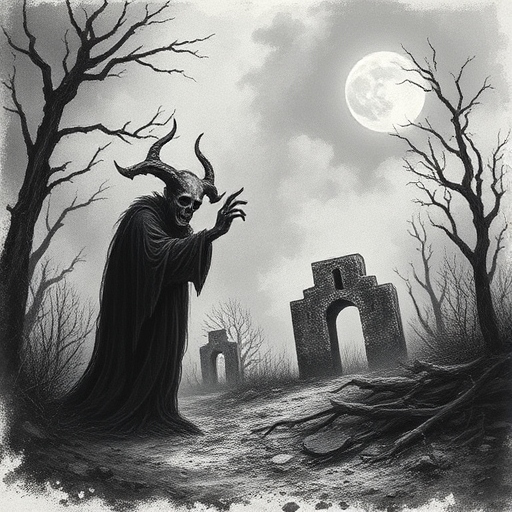
Vampires (Vampiri)
- Characteristics: The Vampire in Romanian folklore is primarily associated with the Nosferatu-type creatures. While the Strigoi often represent the spirits of the dead, the vampire, as understood in Romanian culture, is typically a living person who turns into a creature of the night after their death, feeding on the blood of the living. Vampires are often depicted as handsome, charming, yet sinister beings who have the ability to control animals like wolves or bats.
- Role in Folklore: Vampires are feared creatures that stalk the living, seeking to drain their blood. A vampire is believed to be a deceased person who, due to their misdeeds in life, returns to harm the living. The myth of vampires in Romania is tied to several rituals and beliefs regarding the dead, particularly in rural areas. People believed that certain individuals, especially those who died in mysterious or violent circumstances, had the potential to become vampires.
- Symbolism: Vampires are symbols of death, immortality, and the fear of the unknown. They also represent societal fears regarding death, moral transgression, and the consequences of improper burial or respect for the dead.
Muma Pădurii (Mother of the Forest)
- Characteristics: Muma Pădurii is a female spirit associated with the forest, particularly in rural Romanian folklore. She is often depicted as an old, wild woman with a fierce, intimidating presence, sometimes resembling a witch or a hag. The Muma Pădurii is a protective figure, but she can also be dangerous to those who trespass in her domain.
- Role in Folklore: Muma Pădurii is believed to be a guardian of the forest, watching over the animals and natural elements. In some stories, she is said to guide lost travelers, while in others, she may lead them astray, causing them to become lost or suffer from misfortune. Her role is that of both a protector and a punisher, and she is often associated with nature’s untamed and unpredictable power.
- Symbolism: Muma Pădurii represents the mysterious and potentially dangerous forces of the natural world. She is a symbol of nature’s unpredictability, its ability to protect and nourish, but also its capacity to harm.
Iele
- Characteristics: The Iele are a group of supernatural female beings in Romanian mythology, often compared to fairies, nymphs, or spirits of nature. They are typically described as beautiful young women, dressed in flowing white or green garments, with long, flowing hair. The Iele are said to live in remote places like forests, meadows, or mountains.
- Role in Folklore: The Iele are associated with dance and music, often depicted as enchanting women who seduce men and lead them to their doom. They are believed to appear in the moonlight and engage in mystical dances. However, if anyone interrupts their dance or tries to approach them, the Iele will curse or harm the intruder, often causing madness, illness, or even death. In some tales, they are seen as guardians of the wild and protectors of nature.
- Symbolism: The Iele represent the seductive and dangerous aspects of femininity, nature, and the untamed wilderness. Their beauty and music lure people into dangerous situations, highlighting the balance between attraction and peril.
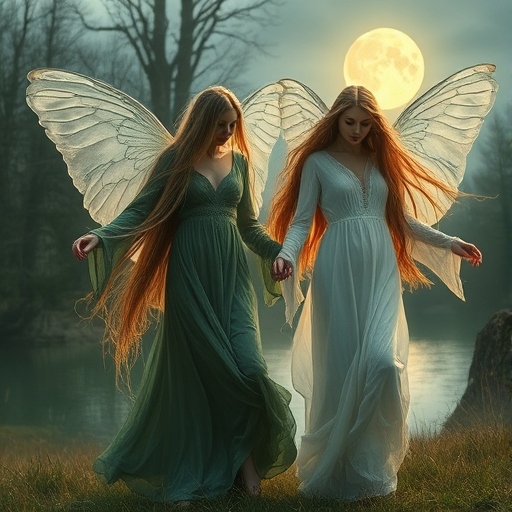
Zână
- Characteristics: The Zână is a benevolent fairy-like creature in Romanian folklore, often depicted as a beautiful, ethereal woman with magical powers. Zâne are typically connected to nature and the elements, and they are considered to be spirits that can bless or curse people depending on their behavior.
- Role in Folklore: Zâne are known for their kindness, often helping those in need, especially women, children, and the poor. They are believed to possess healing abilities and control over natural forces like water, plants, and animals. The Zână can also be vengeful if disrespected, punishing those who harm nature or act with greed or malice. In some stories, the Zână is a guide to the lost or a protector of the innocent.
- Symbolism: The Zână represents the dual nature of nature itself—nurturing, protective, and beneficial but also capable of being destructive if mistreated. The Zână embodies the belief that harmony with nature can bring blessings, while disruption can bring curses.
Capcaun
- Characteristics: The Capcaun is a terrifying creature often described as a giant, with monstrous features, who terrorizes children and travelers. In some legends, it is a half-human, half-animal creature, and in others, it is a large, brute-like being who seeks to devour humans.
- Role in Folklore: The Capcaun is often a villain in Romanian folktales, terrorizing rural areas and kidnapping children. It is usually depicted as a malevolent creature that can be defeated by cunning or bravery. The Capcaun is sometimes seen as a figure that tests the hero’s strength and resolve.
- Symbolism: The Capcaun represents fear, danger, and the unknown. It is often a representation of natural or primal forces that are dangerous and destructive, requiring human ingenuity and courage to overcome.
Balaur
- Characteristics: The Balaur is a mythical creature similar to a dragon, but often depicted with multiple heads (sometimes seven or nine). It is a fearsome and malevolent creature, much like the Western dragon, but with a more serpentine and fantastical appearance. The Balaur is often associated with the power to control storms, thunder, and lightning.
- Role in Folklore: The Balaur is a villain in many Romanian folktales, where it often kidnaps princesses or threatens entire villages. The hero of the story must slay the Balaur to restore peace or rescue someone. In some tales, the Balaur is said to have magical powers or to guard treasures or magical objects.
- Symbolism: The Balaur represents chaos, destruction, and the forces of evil that must be overcome by courage and virtue. It is a symbol of the trials that heroes face on their journey toward victory.
Moș Crăciun (Santa Claus)
- Characteristics: Moș Crăciun is the Romanian version of Santa Claus, similar to the Western figure but with distinct cultural differences. He is often depicted as a bearded, jolly old man who delivers gifts to children during Christmas, but in Romanian traditions, he is more closely associated with the New Year and Epiphany.
- Role in Folklore: Moș Crăciun is a benevolent figure who rewards good children with gifts and candy. He is part of the larger tradition of holiday festivities, which includes singing carols and celebrating the coming of the new year.
- Symbolism: Moș Crăciun symbolizes the spirit of giving, generosity, and the celebration of the winter season. He also represents the joy and warmth of family traditions during the holidays.
Conclusion
Romanian folklore is filled with fascinating and diverse magical beings, many of which reflect the fears, hopes, and values of the people. From the malevolent Strigoi and Vampires to the benevolent Zână and Iele, these figures represent a wide array of supernatural forces—both protective and destructive—that have shaped the cultural landscape of Romania. The stories of these magical beings continue to be told and celebrated, preserving a rich tradition of myth and legend that connects the people of Romania with their past.
Danish Beings
Danish folklore is rich in mystical beings and supernatural creatures, often blending Norse mythology, medieval Christian influences, and rural traditions. These beings play crucial roles in the cultural imagination, often embodying the forces of nature, good versus evil, and the boundaries between the human world and the supernatural. Here are some of the most notable magical beings in Danish folklore:
Nisser (Elves or Goblins)
- Characteristics: The Nisse (singular) or Nisser (plural) are small, impish creatures in Danish folklore, similar to elves or goblins. They are often depicted as small, bearded men wearing red hats, and they are typically no taller than a child. Nisser are known for their mischievous behavior but are also associated with providing help in exchange for respect and offerings.
- Role in Folklore: The Nisser are said to live on farms and in homes, where they act as protectors of the household, especially animals, and crops. However, if they are not treated with respect, they can become spiteful, playing pranks, and causing trouble, such as knocking over milk pails or hiding tools. It was customary to leave a bowl of porridge or a treat for the Nisse to maintain goodwill, as their favor was considered crucial for a successful harvest and a well-run household.
- Symbolism: The Nisse represents the forces of nature and the balance between helpfulness and mischief. Their dependence on respect and offerings from humans symbolizes the interdependence between people and the natural world, particularly in agricultural life.
Huldra
- Characteristics: The Huldra is a forest spirit often portrayed as a beautiful woman with long, flowing hair and a tail, sometimes resembling that of a cow or a fox. She is typically depicted as wearing a simple dress, and in some versions of the myth, she has a hollow back, which she hides from view. The Huldra is a seductive and mysterious figure, known for luring men into the forest.
- Role in Folklore: The Huldra is a creature associated with the forest and nature, often described as both alluring and dangerous. She may lead men astray into the woods, where they may become lost or be lured into her lair. However, if treated kindly and with respect, she may offer help or show favor, such as assisting with hunting or providing good fortune. In some versions of the myth, the Huldra is portrayed as a figure who can marry a human, but the man must never look at her back, or the spell will be broken, and the Huldra will disappear.
- Symbolism: The Huldra represents the seductive and elusive forces of nature. Her dual nature as both a helpful and dangerous figure highlights the ambiguous and unpredictable qualities of the natural world, where beauty and danger often coexist.
Danish Trolls
- Characteristics: Trolls in Danish folklore are often depicted as large, ugly, and brutish creatures, typically living in mountains, caves, or forests. They can have many different forms, from giant, hideous beings to smaller, more mischievous creatures. They are commonly portrayed as dim-witted, greedy, and dangerous, though in some stories, they may be somewhat comical or bumbling.
- Role in Folklore: Trolls are often antagonistic figures in Danish folktales, engaging in conflict with humans, heroes, or other supernatural creatures. They may try to steal from humans or abduct children, and their actions are often thwarted by cleverness or bravery. Trolls are known to be particularly vulnerable to sunlight, which turns them to stone. This is a common motif in Scandinavian folklore, and it is often depicted in stories where trolls are defeated when they are caught out in the open during the day.
- Symbolism: Trolls represent the dangers and challenges of the wilderness. They are symbolic of the unknown and chaotic forces of nature, standing as a contrast to human civilization. The trope of trolls turning to stone in sunlight may symbolize the triumph of reason and light over darkness and ignorance.
The Lindworm
- Characteristics: The Lindworm is a type of serpent or dragon in Danish folklore, often depicted as a wingless dragon-like creature with a long, sinuous body, sometimes with multiple heads. Unlike the typical dragon, the Lindworm is not necessarily fire-breathing, but it is still a fearsome creature.
- Role in Folklore: The Lindworm is often a menace to local communities, terrorizing towns or villages. It is typically slain by a hero or knight in traditional folklore, similar to the dragon-slaying myths found in other cultures. In some stories, the Lindworm represents a form of chaos or a destructive force that must be overcome to restore order and peace.
- Symbolism: The Lindworm symbolizes the untamed forces of nature that threaten human society. It embodies the themes of struggle, conflict, and the battle against destructive or chaotic elements.
Bjørnekongen (Bear King)
- Characteristics: The Bjørnekongen, or Bear King, is a figure in Danish and Scandinavian folklore who rules over the wild bears. In some stories, the Bear King is a shape-shifter, capable of transforming between human and bear form. He is often depicted as a fierce and regal figure who commands the respect of both humans and animals.
- Role in Folklore: The Bear King is typically a benevolent ruler who protects the animals and forests, but in some versions of the myth, he is a more fearsome or even vengeful figure. He may be a figure of power and wisdom, or he may engage in battles against human hunters, who seek to kill his subjects. The Bear King may also serve as a guide for those who wish to gain his favor or seek wisdom from him.
- Symbolism: The Bjørnekongen represents the power of nature and the wild, particularly the untamed strength and majesty of the bear. He symbolizes the dual nature of the wilderness—both protective and dangerous—and highlights the reverence and fear that humans may have for powerful animals and the natural world.
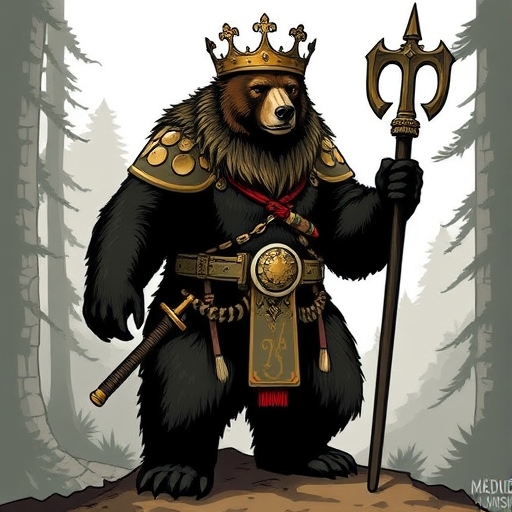
The Mærke
- Characteristics: The Mærke is a spirit or ghost in Danish folklore, often linked to a place or event. The Mærke is said to be the spirit of someone who has died under mysterious or tragic circumstances, or it may be a manifestation of a curse or misfortune. It can be seen as a type of restless ghost, seeking to complete unfinished business or seeking revenge.
- Role in Folklore: The Mærke is typically a malevolent spirit, causing misfortune or harm to those who encounter it. It is sometimes associated with specific locations, like an old house or a forest clearing, and people would avoid these areas to escape the spirit’s influence. The Mærke may also be a warning to others about the consequences of certain actions, such as betrayal or violence.
- Symbolism: The Mærke represents the lingering consequences of tragedy and the unresolved business of the dead. It embodies the idea that death is not always the end and that spirits can return to the living world if their death is not properly avenged or if they have been wronged.
The Skovkoner (Forest Women)
- Characteristics: The Skovkoner are female spirits associated with the forest, much like the Huldra in Norwegian folklore. These women are often depicted as beautiful, but they are also connected to the wild, untamed forces of nature. Some are seen as helpful and protective, while others are dangerous and unpredictable.
- Role in Folklore: Skovkoner are believed to be guardians of the forest, watching over animals and plants. In some stories, they may help lost travelers find their way or provide them with food, but they can also lead people astray or punish those who harm the natural world. Their power is often linked to their deep connection with the forest and nature’s cycles.
- Symbolism: The Skovkoner symbolize the mystical and enigmatic qualities of nature, representing both the nurturing and vengeful aspects of the wilderness. Their duality reflects the balance between harmony with nature and the dangers of its untamed forces.
Conclusion
Danish folklore is rich with magical beings and creatures that embody the mystical and mysterious forces of nature, human existence, and the supernatural. From the mischievous Nisser and seductive Huldra to the menacing Trolls and fearsome Lindworm, these creatures reflect both the beauty and danger inherent in the natural world. Danish folklore, like other Nordic traditions, emphasizes the importance of respect for the natural world and the forces beyond human control, often illustrating the consequences of disrupting the balance between humanity and the supernatural. These beings continue to shape Danish culture, literature, and traditions, preserving a deep connection to the mythic past.
Mexican Beings
Mexican folklore is a rich and diverse tapestry of supernatural beings, legends, and myths, deeply influenced by Indigenous traditions, Spanish colonization, and a blend of various cultural influences. The magical beings of Mexican folklore often embody the intersection of the natural world, human experiences, and the spiritual realm. These beings are portrayed in various ways, from protective spirits to malevolent forces, reflecting the complex relationship between humans, nature, and the afterlife in Mexican culture. Here are some of the most notable magical beings and spirits in Mexican folklore:
La Llorona (The Weeping Woman)
- Characteristics: La Llorona is one of Mexico’s most famous and haunting figures in folklore. She is depicted as a ghostly woman who roams near rivers, lakes, or other bodies of water, weeping for her lost children. The legend varies, but she is often described as a woman dressed in white, with long, flowing hair, who wails “¡Ay, mis hijos!” (“Oh, my children!”).
- Role in Folklore: According to the most common version of the story, La Llorona was a mother who drowned her children in a moment of madness or despair and is now condemned to wander the earth, mourning their loss. She is often seen as a warning for children to stay away from dangerous bodies of water or to behave well. In some versions, La Llorona can also be a figure of vengeance, preying on children who misbehave or wander too far from home.
- Symbolism: La Llorona represents grief, guilt, and the consequences of maternal loss. She embodies the intersection of death, regret, and the fear of punishment. Her constant weeping is symbolic of eternal suffering, and she serves as a cautionary tale about the consequences of neglecting one’s responsibilities.
El Charro Negro (The Black Cowboy)
- Characteristics: El Charro Negro is a ghostly figure in Mexican folklore, often depicted as a handsome man dressed as a traditional Mexican cowboy (charro) but with a dark, sinister presence. He rides a black horse and is usually seen at night. His appearance is often accompanied by a feeling of unease or foreboding.
- Role in Folklore: El Charro Negro is often associated with tales of temptation, making deals with mortals, particularly young men or women. He may offer riches, fame, or power in exchange for the soul or a pact with the devil. He is a figure who represents the danger of making deals with dark forces or sacrificing one’s soul for material gain. The tale usually ends with the victim’s downfall, as the Charro Negro claims their soul.
- Symbolism: El Charro Negro represents temptation, greed, and the consequences of making morally questionable decisions. His association with darkness and the supernatural makes him a figure that warns against making pacts with evil forces.
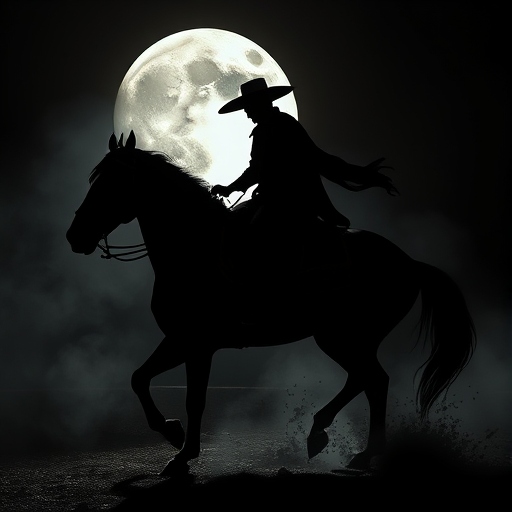
El Chaneque
- Characteristics: The Chaneque is a spirit or mythical creature from the folklore of central and southern Mexico, particularly in the Veracruz and Oaxaca regions. It is often described as a small, impish being that can be either malevolent or playful. They are similar to elves or mischievous fairies, and they are known to live in the forests or mountains, hiding in the shadows and causing confusion.
- Role in Folklore: The Chaneques are known for playing tricks on humans, such as leading travelers astray, causing them to become lost, or stealing personal belongings. In some versions of the legend, the Chaneques may also try to deceive people into becoming lost in the forest or spirit world, where they will be trapped forever. They are often seen as protectors of nature, punishing those who harm the environment.
- Symbolism: The Chaneque embodies the untamed, mystical side of nature. He represents the dangers of the wilderness and the importance of respecting nature and the spiritual world. His trickster nature also reflects the unpredictability of the world and the consequences of arrogance or disrespect.
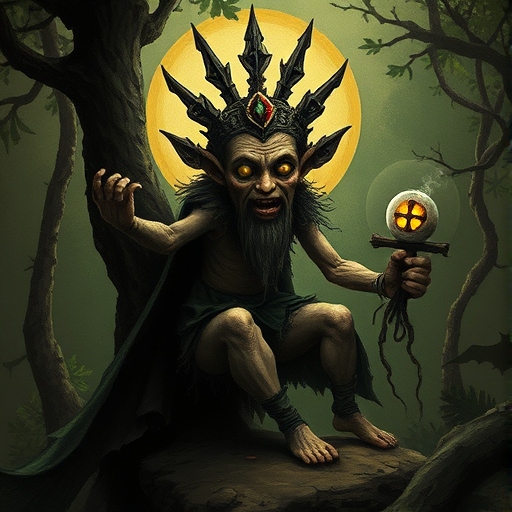
La Mala Hora (The Evil Hour)
- Characteristics: La Mala Hora, or “The Evil Hour,” is a ghostly figure associated with late-night or early-morning hours, particularly between midnight and 3 a.m. She is said to be a terrifying female spirit or apparition, often described as a dark figure or a shadowy presence that brings bad luck or misfortune.
- Role in Folklore: The presence of La Mala Hora is often tied to feelings of dread and unease, and she is said to appear to people during the hours when they are most vulnerable, either on lonely roads or in their homes. Some versions suggest that she causes illness or misfortune, while others believe she serves as a harbinger of death or disaster.
- Symbolism: La Mala Hora represents fear, the unknown, and the darker aspects of the night. Her role in folklore suggests the fear of death and misfortune, as well as the idea that certain times are cursed or bring about ill-fated events.
Tezcatlipoca
- Characteristics: Tezcatlipoca is one of the most important deities in Aztec mythology, often depicted as a powerful and intimidating figure with a smoking mirror in his hand. He is a god associated with fate, divination, the night sky, and sorcery, and he embodies both creation and destruction. Tezcatlipoca is often shown as a warrior or ruler, capable of changing his appearance at will.
- Role in Folklore: Tezcatlipoca is considered a trickster god, often testing the lives of mortals by tempting them, creating obstacles, and causing turmoil. He is linked to the unpredictable forces of life and death. Tezcatlipoca’s mirror is believed to reflect a person’s true nature, exposing hidden truths or secrets. In some myths, he is portrayed as a god who seeks to maintain balance by balancing both good and evil, while in others, he is seen as a force of chaos.
- Symbolism: Tezcatlipoca represents duality, fate, and transformation. His role as a god of temptation, change, and moral testing reflects the complex forces that govern human existence, where success and failure are often intertwined.
La Tunda
- Characteristics: La Tunda is a mythological figure in the folklore of the Afro-Mexican communities, particularly in the coastal regions of Veracruz. She is described as a woman with the body of a beautiful, seductive female but with the ability to transform into a terrifying, monstrous figure with the head of an animal or a reptile. She is often depicted as having long, wild hair and a sinister, predatory nature.
- Role in Folklore: La Tunda is known for luring people into the forest or marshes, where she can either take vengeance on them or seduce them. She often appears to men who have wronged women, especially those who have been unfaithful. La Tunda is said to punish such men by transforming them into beasts or leading them into a situation where they are lost or killed.
- Symbolism: La Tunda represents the themes of revenge, justice, and the power of the natural world. She is a force of feminine power and retribution, punishing those who violate social or moral codes, especially in relation to women.
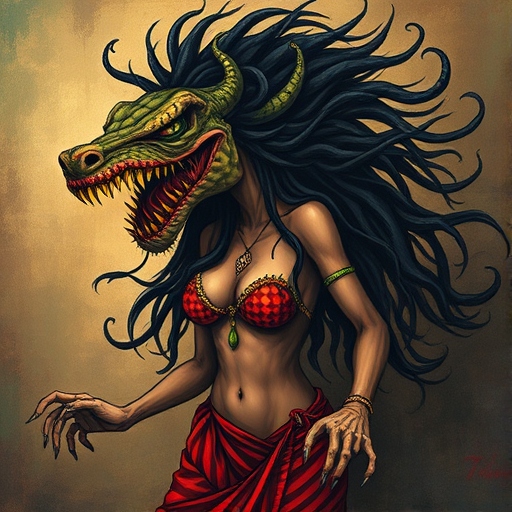
El Cucuy (The Boogeyman)
- Characteristics: El Cucuy is the Mexican equivalent of the Boogeyman, a mythical creature used to scare children into behaving. He is often described as a monstrous, shadowy figure who comes to take away children who misbehave, especially those who wander too far from home or refuse to sleep.
- Role in Folklore: El Cucuy is primarily used as a cautionary figure by parents to encourage children to behave. He is said to hide in the shadows, under beds, or in closets, waiting for the right moment to strike. The figure of El Cucuy may vary in appearance depending on the region, but it is universally portrayed as a terrifying creature who preys on children.
- Symbolism: El Cucuy symbolizes fear, authority, and control. He embodies the fear of the unknown and the consequences of disobedience. His role in folklore reflects the use of supernatural stories to teach children boundaries and social norms.
Conclusion
Mexican folklore is teeming with mystical beings and spirits that are deeply rooted in the country’s cultural heritage, blending Indigenous, African, and Spanish influences. From the tragic and vengeful La Llorona to the trickster-like Chaneque and the terrifying El Cucuy, these figures represent the complex relationship between humans and the supernatural, exploring themes of death, guilt, temptation, and the forces of nature. Mexican folklore continues to shape the cultural identity of the country, serving as a powerful tool for storytelling, moral lessons, and the preservation of traditions.
Nigerian Beings
Nigerian folklore is a rich and diverse tradition that spans across various ethnic groups, including the Yoruba, Igbo, Hausa, and many others. The country’s folklore includes a wide range of magical beings, spirits, and supernatural entities, many of which play central roles in traditional beliefs, stories, and rituals. These beings often reflect the spiritual worldview of the Nigerian people, dealing with themes of creation, morality, ancestors, and the forces of nature. Below are some of the most notable magical beings and supernatural figures in Nigerian folklore:
Orisha (Yoruba Religion)
- Characteristics: The Orisha are deities or spirits in the Yoruba religious tradition, which is one of the most prominent religious and spiritual practices in Nigeria, especially among the Yoruba people. These gods and goddesses are believed to govern various aspects of the natural world and human existence. Each Orisha has distinct attributes, responsibilities, and characteristics, and they are worshipped through rituals, songs, and prayers. Some well-known Orishas include Eshu, the trickster god of communication and fortune; Yemaya, the mother goddess of the sea and fertility; and Shango, the god of thunder and fire.
- Role in Folklore: The Orisha are central figures in Yoruba cosmology and are believed to interact directly with humans, often intervening in the affairs of the world. They are believed to possess great powers over the forces of nature, life, and death. Offerings, sacrifices, and rituals are performed to honor them and seek their favor. The Orisha can act as protectors, healers, or avengers, and they are deeply tied to both the spiritual and material worlds.
- Symbolism: The Orisha symbolize the balance between nature, humanity, and the divine. Each Orisha represents an elemental or natural force, such as water, fire, earth, or air, and their stories often embody themes of wisdom, power, justice, and harmony with the universe.
Anansi (Igbo Folklore)
- Characteristics: Anansi is a trickster god that appears in many African cultures, including the Igbo people of Nigeria. He is often depicted as a spider, though he can sometimes appear as a human or a combination of both. Anansi is known for his cunning, intelligence, and ability to outwit others, often using his wits to overcome physical strength or obstacles.
- Role in Folklore: In Igbo stories, Anansi is a shape-shifter and a master of deception, sometimes helping or hindering humans. His tales often teach moral lessons about the use of intelligence, resourcefulness, and the consequences of dishonesty. He is also known for playing pranks and tricking other gods, making him both a beloved and a controversial figure in Nigerian folklore.
- Symbolism: Anansi represents the power of the mind over brute strength and the importance of wit and cleverness in navigating the world. He also embodies the ambiguity of morality, as his actions can be both mischievous and beneficial, depending on the context.
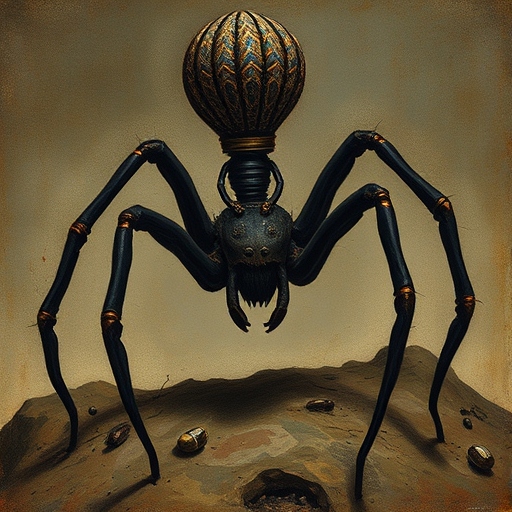
Aja (Yoruba Spirit of the Forest)
- Characteristics: The Aja is a forest spirit in Yoruba mythology, often depicted as a protective and powerful being associated with nature, particularly the forest. The Aja is thought to have deep connections with the wild and untamed aspects of the natural world, including animals, trees, and the land itself. These spirits are believed to have the power to protect people from harm, but they also demand respect for the environment and nature.
- Role in Folklore: The Aja is said to be a guardian spirit of the forests, and humans who venture too deeply into the forest or disrespect nature may anger the Aja and incur misfortune. The Aja spirits are also believed to communicate with humans through dreams and visions, guiding them on their spiritual journeys.
- Symbolism: The Aja represents the sacredness of nature and the need for respect between humans and the environment. These spirits are believed to be guardians of ecological balance, and their stories emphasize the interconnectedness of all living things.
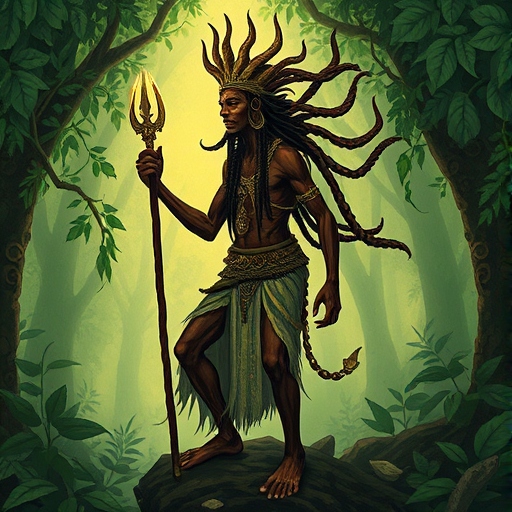
Mami Wata (Water Spirit)
- Characteristics: Mami Wata is a water spirit that is widely worshipped across various parts of Africa, including Nigeria, especially in the Niger Delta region. Mami Wata is often depicted as a beautiful woman with long, flowing hair, and sometimes as a mermaid or a half-human, half-fish figure. She is associated with rivers, seas, and other bodies of water, where she is believed to have the power to control the flow of water and the fate of those who encounter her.
- Role in Folklore: Mami Wata is a complex figure in Nigerian folklore, often seen as both a benevolent and vengeful spirit. She can be a protector and healer, bestowing wealth, beauty, and fertility upon those who honor her, but she can also be dangerous, causing storms, drowning people, or bringing misfortune to those who disrespect her. Mami Wata is often linked to ideas of beauty, temptation, and the unknown, and she is sometimes portrayed as a seductress who leads people astray.
- Symbolism: Mami Wata represents the mysterious and powerful forces of water and the emotions connected to it. Her dual nature as both a life-giver and a destroyer symbolizes the ambivalence of nature and the need for balance in one’s relationship with the natural world.
Ogun (Yoruba God of Iron and War)
- Characteristics: Ogun is one of the most revered Orishas in Yoruba mythology. He is the god of iron, war, hunting, and technology, and is depicted as a powerful, often fearsome figure associated with tools, weapons, and craftsmanship. Ogun is said to be the creator of iron tools and is linked to the development of human civilization through the use of metalworking.
- Role in Folklore: Ogun is a protector of warriors, hunters, and anyone who uses tools to achieve their goals. His strength and ability to forge weapons make him a central figure in stories of battles and triumphs, but he also represents the discipline and hard work required to achieve greatness. Rituals to Ogun often involve offerings of iron, tools, or sacrifices related to work and labor.
- Symbolism: Ogun symbolizes strength, determination, and the human capacity to shape and transform the world. He embodies the importance of hard work and the mastery of craft, as well as the destructive and creative power of weapons and tools.
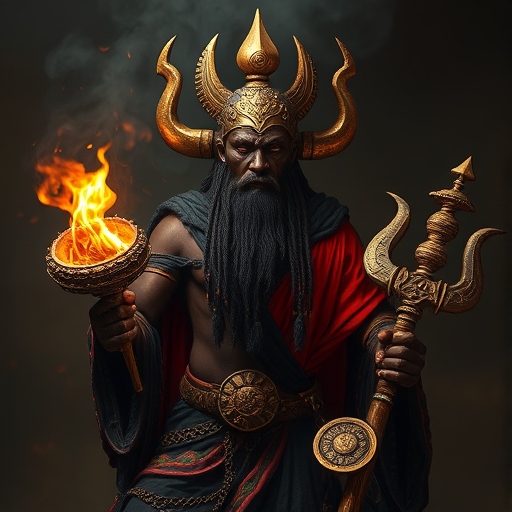
Esu (The Trickster and Messenger God)
- Characteristics: Esu is another major Orisha in Yoruba religion, often described as the trickster god and the messenger between humans and the other gods. He is known for his wit, humor, and unpredictability. Esu is a powerful figure who controls communication and the crossroads, both literal and metaphorical. He is often depicted as a playful figure with a mischievous streak, capable of causing confusion or chaos.
- Role in Folklore: Esu’s primary role is as a mediator and communicator between the mortal world and the spiritual realm. He is also associated with fate and destiny, influencing the paths that people take in life. Esu’s trickster nature means he can cause both good and bad fortune, depending on how people approach him. He is also involved in initiating sacrifices and rituals for other Orishas and is essential in the Yoruba religious practices.
- Symbolism: Esu represents the forces of chance, fate, and duality. His trickster nature highlights the unpredictable nature of life and the role of communication in shaping human destiny. He is a reminder that not everything in life is fixed or certain and that one’s path is influenced by forces beyond human control.
Abiku (The Spirit Child)
- Characteristics: The Abiku is a spirit child in Yoruba and other Nigerian folklore, often seen as a spirit or soul that enters the body of a human child, only to die shortly after birth and return to the spirit world. This cycle of birth, death, and rebirth is said to happen repeatedly, with the Abiku spirit causing the child to die at an early age.
- Role in Folklore: The Abiku is believed to be a restless spirit, often born into a family to cause pain and suffering. Some versions of the tale suggest that the spirit child can be appeased or exorcised through rituals and sacrifices. In other versions, the Abiku’s return may be seen as an omen or a reminder of the fragility of life and the cycle of life and death.
- Symbolism: The Abiku symbolizes the mystery of life and death, as well as the belief in reincarnation or the persistence of the soul. It represents the connection between the living and the spirit world and reflects the fears and hopes surrounding childbearing and the afterlife.
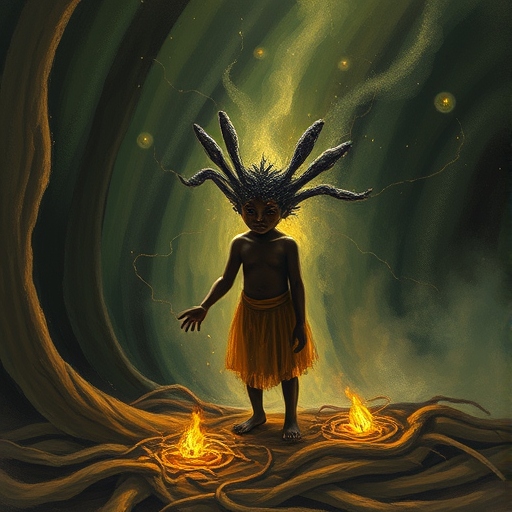
The Asiman (Igbo Witch)
- Characteristics: The Asiman is an Igbo witch or spirit associated with malevolent magic. Often depicted as a shapeshifter, the Asiman is believed to have the power to turn into animals, particularly birds, and wreak havoc on the lives of humans. The Asiman is believed to possess magical abilities that can cause harm, illness, or death to those who cross her path.
- Role in Folklore: The Asiman is a figure of fear and superstition in Igbo folklore. Witches like her are often said to operate in secrecy, using their powers to cause suffering and misfortune. In some stories, the Asiman can be defeated by magical countermeasures or by exposing her true identity.
- Symbolism: The Asiman represents the hidden dangers and fears of the supernatural world. She embodies the fear of invisible forces and the consequences of misuse of power, especially the power to cause harm to others.
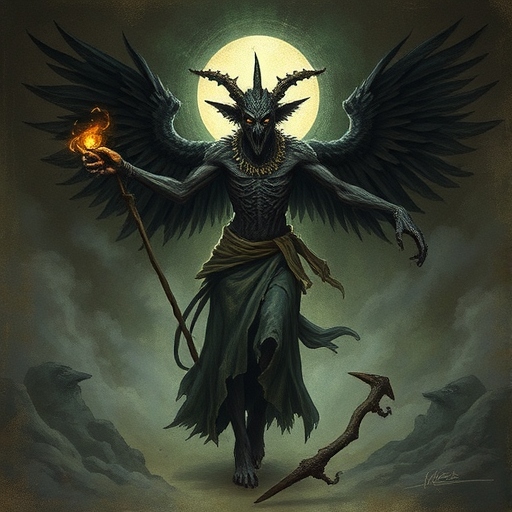
Conclusion
Nigerian folklore is a rich blend of mythological creatures, spirits, and magical beings, many of whom play vital roles in shaping the beliefs, practices, and moral codes of different ethnic groups. Whether through the powerful Orisha, the trickster Esu, or the protective Aja, these beings reflect a deep connection between the spiritual world, nature, and human existence. The magical beings of Nigerian folklore continue to influence contemporary culture, from storytelling and literature to religious practices and daily life.
Caribbean Beings
Caribbean folklore is a vibrant mix of indigenous traditions, African influences (particularly from the Yoruba, Akan, and Congo peoples), European (mainly Spanish, French, and British) colonial legacies, and elements of Asian cultures due to migration. This blend has given rise to a fascinating array of magical beings and supernatural figures across the Caribbean, which vary from island to island. These figures often serve as a reflection of the complex social, historical, and spiritual landscape of the Caribbean.
Here are some of the most notable magical beings and supernatural figures found in Caribbean folklore:
Jumbie (General Caribbean Folklore)
- Characteristics: The term Jumbie is used across many Caribbean islands to describe malevolent spirits or supernatural entities. These spirits are often thought to be the souls of the dead who have not properly moved on or spirits that have been disturbed. Jumbies can be tricky and vengeful, and they are often said to cause harm, misfortune, or illness to the living.
- Role in Folklore: In some stories, Jumbies are believed to be responsible for mysterious deaths, accidents, or illness. They are typically associated with the night, and people are advised to be cautious after dark, particularly near graveyards, forests, or remote areas. Jumbies may possess people or animals, causing them to behave in strange or violent ways. However, not all Jumbies are malicious—some are simply lost or confused souls.
- Symbolism: Jumbies represent the fear of death, the afterlife, and the unknown. They symbolize the unresolved conflicts or injustices of the past and the eerie consequences of improper burial or disrespect for the dead.
La Diablesse (Caribbean, especially in French-speaking regions)
- Characteristics: The La Diablesse is a female spirit in Caribbean folklore, particularly prevalent in French-speaking islands such as Martinique, Guadeloupe, and Haiti. She is typically described as a beautiful, seductive woman who lures men into dangerous situations, often leading them to their deaths. Her appearance is usually enchanting, but she has a supernatural quality, with one foot sometimes described as a cloven hoof or animal-like.
- Role in Folklore: La Diablesse is often seen as a trickster figure, leading unsuspecting men into isolated or perilous places, such as forests or remote parts of villages. Once she has led them astray, they may fall victim to the environment or supernatural forces. In some stories, La Diablesse can also be a seductress, enticing men with promises of love and affection, only to reveal her true form as a demonic entity.
- Symbolism: La Diablesse represents the dangers of temptation, lust, and vanity. She embodies the fear of seductive power and the consequences of being deceived by appearances. Her stories also serve as warnings about trusting strangers or people who seem too good to be true.
Soucouyant (Caribbean, especially in Trinidad and Tobago, and other parts of the Caribbean)
- Characteristics: The Soucouyant is a vampire-like creature in Caribbean folklore, particularly popular in Trinidad and Tobago and other islands influenced by African and French Creole traditions. She is usually depicted as an old woman who, by day, appears as a normal human, but by night, she sheds her skin and becomes a fiery ball of light that flies through the air to suck the blood of her victims.
- Role in Folklore: The Soucouyant is often said to attack people during the night, particularly when they are asleep, and drain their blood. She may be difficult to detect in her human form, but there are certain signs, such as an unpleasant smell or the absence of her skin, that can reveal her true nature. In some stories, the Soucouyant can be defeated by sprinkling salt or other protective measures around her home, or by catching her and forcing her to return to her human form.
- Symbolism: The Soucouyant represents the fear of vampirism, blood-draining, and the unknown. She is also a symbol of the tension between outward appearances and hidden dangers, as she can appear as a harmless old woman but is, in fact, a deadly predator. The Soucouyant is a reminder of the darkness that can lurk beneath the surface of everyday life.
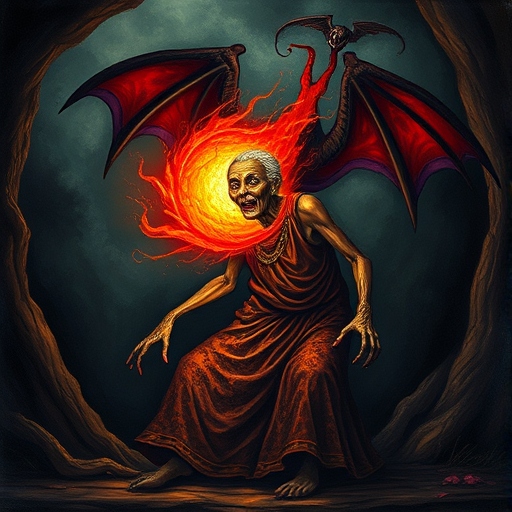
Duppy (Jamaican and Caribbean Folklore)
- Characteristics: The Duppy is a ghost or spirit in Caribbean folklore, particularly in Jamaica. Duppies are the souls of the dead who have not found peace and are believed to haunt the living. Duppies can take on various forms, including human, animal, or other supernatural shapes, and they are often associated with malevolent actions.
- Role in Folklore: Duppies are typically feared as restless spirits who seek revenge or cause mischief. They are known to disturb people in their homes, sometimes causing illness, bad luck, or accidents. In many stories, Duppies are said to have unfinished business, and they may return to seek justice or closure for their deaths. Sometimes, they are depicted as protectors, guarding certain areas or families from harm.
- Symbolism: Duppies represent the unresolved, lingering presence of the dead and the belief in the power of spirits to influence the living world. They symbolize the cultural connection between the living and the dead and highlight the importance of rituals and proper burial practices to ensure peace for the departed.
Papa Bois (Caribbean, particularly in Trinidad and Tobago)
- Characteristics: Papa Bois is a legendary figure in Trinidadian folklore. He is often described as a half-man, half-animal being, typically depicted with the body of a man and the head of a goat or deer, symbolizing his close connection to the forest and nature. Papa Bois is considered a protector of the forest and its animals.
- Role in Folklore: Papa Bois is believed to guide and protect the creatures of the forest, ensuring that they are not harmed by humans. He is often portrayed as a wise and sometimes mischievous figure who helps those who show respect for nature and punishes those who mistreat the environment or wildlife. He is known to have a deep knowledge of the forest and its secrets.
- Symbolism: Papa Bois represents the relationship between humans and nature. He is a protector of the environment and wildlife, reminding people of the importance of respecting the natural world. His figure embodies the mysticism of the forest and the interconnectedness of life and nature.
The Loup-Garou (French Caribbean)
- Characteristics: The Loup-Garou, or werewolf, is found in French Caribbean folklore, especially in regions influenced by French colonialism. The Loup-Garou is a shape-shifting creature that can transform from a human into a wolf or other animal, often under the influence of the moon or in response to certain rituals or curses.
- Role in Folklore: The Loup-Garou is often portrayed as a creature of the night, terrorizing the countryside, attacking livestock, and sometimes even humans. In some stories, the transformation is voluntary, and the Loup-Garou can be a person who has made a pact with the devil or engaged in dark magic. In other versions, the transformation is involuntary, occurring due to a curse or a family lineage.
- Symbolism: The Loup-Garou represents the fear of uncontrollable transformation and the loss of human identity. It is also a symbol of the dangers that lurk in the wilderness and the wildness of nature. The creature reflects themes of duality, humanity, and the animalistic instincts that lie beneath the surface of civilized life.
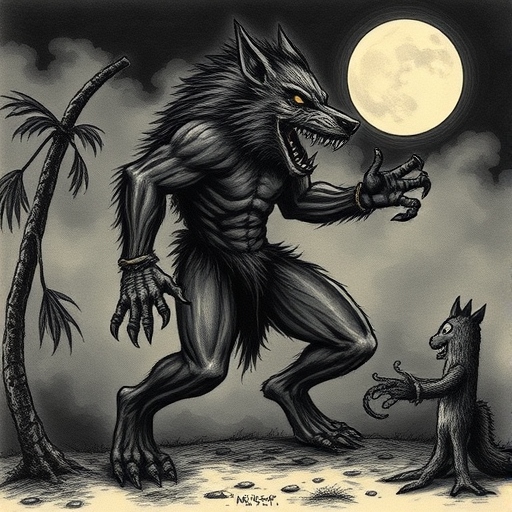
Shouters (Caribbean, particularly in Jamaica)
- Characteristics: The Shouters are believed to be spirits of the dead in Jamaican folklore, often associated with the spiritual world. These beings are said to be people who have died but whose spirits remain earthbound, known for their loud, wailing cries or shouts. They are sometimes thought to be souls who were not properly buried or those who met untimely deaths.
- Role in Folklore: Shouters are often linked to death, misfortune, and the restless spirits of the deceased. They are believed to manifest in areas where death or tragedy has occurred and may be heard calling out or wailing. Some believe that they are warning signals, alerting the living to dangers or ill omens.
- Symbolism: Shouters symbolize the persistent nature of death and the belief that the dead can have unfinished business with the living. They embody the idea of spirits who are trapped between worlds, unable to rest in peace due to unresolved issues.
Conclusion
Caribbean folklore is filled with magical beings and supernatural entities that reflect the region’s diverse cultural history, from African spiritual traditions to European colonial influences. These beings serve as both cautionary figures and symbols of the natural and spiritual forces that shape life in the Caribbean. From the seductive La Diablesse and the vampiric Soucouyant to the protective Papa Bois and mischievous Jumbies, these figures continue to inspire stories, rituals, and cultural expressions across the Caribbean today.

Leave a Reply